
archives for 06/2015
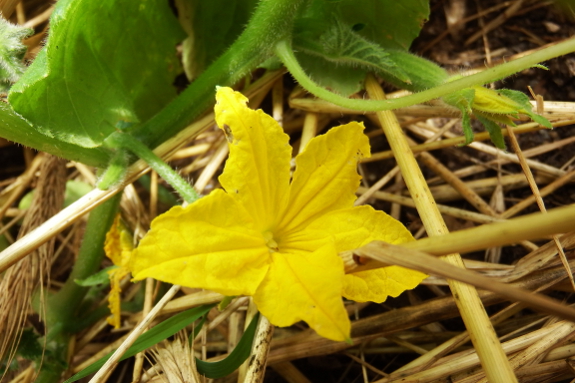
For me, the first day of
summer occurs when I notice the initial brilliant yellow cucurbit
flower. Which means my own solstice was Sunday when our cucumbers
heralded the sun and promised fruits in the near future.
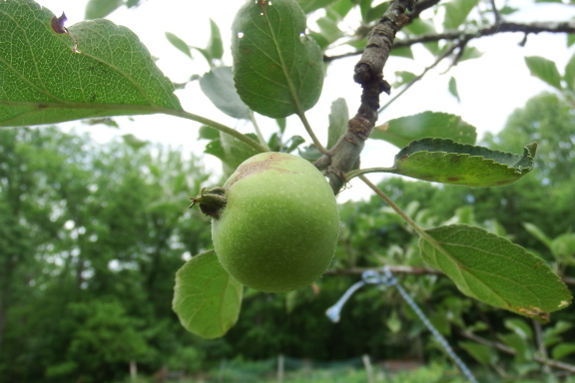
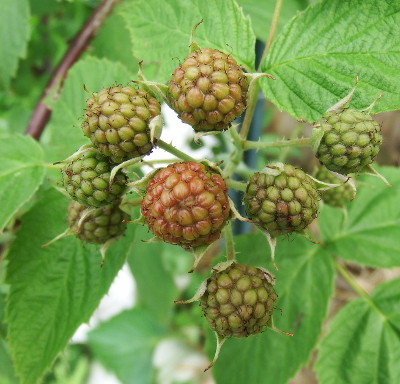 Speaking
of fruits, it looks like four apple fruits made it through dogwood
winter intact. My neighbor who lives a mile away on a south-facing
hillside tells me that his trees are loaded, though, which makes me
think I need to get more serious about finding non-frost-pocket
locations for tree fruits if I want real harvests of apples and pears.
Speaking
of fruits, it looks like four apple fruits made it through dogwood
winter intact. My neighbor who lives a mile away on a south-facing
hillside tells me that his trees are loaded, though, which makes me
think I need to get more serious about finding non-frost-pocket
locations for tree fruits if I want real harvests of apples and pears.
Of course, berries
continue to do well for us. This is actually only a so-so year for
strawberries due to our "straw" mulch sprouting cover crops last winter,
a hard dogwood winter that nipped some blooms even beneath row covers,
and lack of rain resulting in small berries. Despite these setbacks,
though, we're each still enjoying a big bowl of berries twice a day and
have put a few sheets of leather away in the freezer.
Meanwhile, our second black raspberry variety --- Jewel --- looks like it's going 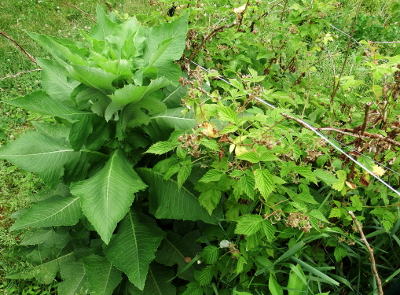 to
be ultra early, ripening up before our Caroline red raspberries this
year. So soon there will be more types of berries in our daily bowl.
to
be ultra early, ripening up before our Caroline red raspberries this
year. So soon there will be more types of berries in our daily bowl.
Now, if I can just manage
to weed the red raspberries before they ripen --- and before the wild
lettuce outgrows my cultivated plants --- we'll be back in business. I'd
been waiting for rain to soften the ground before hitting those holdout
beds, but I guess I'll just irrigate harder and pull those weeds.
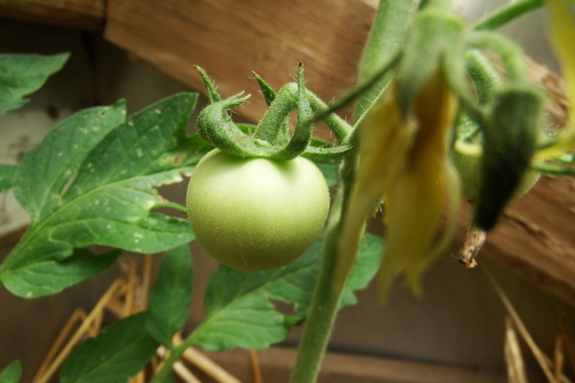
In other garden news, between last week's jolt of precipitation and Mark's irrigation,
our tomato plants nearly doubled in size over the last seven days. If I
had to pick one favorite vegetable, tomatoes might be it, so I watch
the developing fruits with an eagle eye. The fruit pictured above is our
biggest so far.
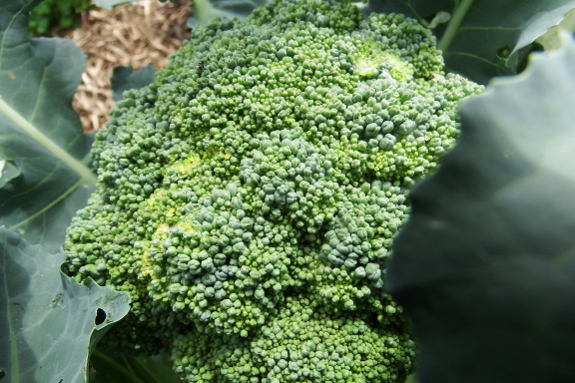
Mark instead keeps his
attention attuned to the broccoli and peas. The latter have been
producing for a couple of weeks now, but dry weather and highs near 90
mean peas are only trickling in.
On the other hand, this year's broccoli has surprised me by doing well
despite only getting not-really-composted chicken bedding for
fertilizer, then having to deal with the same summery temperatures that
the peas hate. I've been watching lots of cabbage whites flutter around
the broccoli plants, but my weekly caterpillar-squashing sessions
have seen very few pest insects. Maybe something about this year's
conditions made the plants less tasty to bugs? The broccoli certainly
didn't taste anything less than excellent to us when we enjoyed our
first heads this weekend!
I hope your garden is shaping up well despite inevitable setbacks. It's time to start enjoying the bounty!
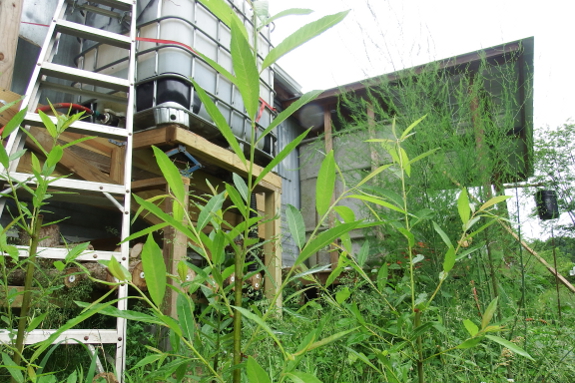
Mark's words of wisdom: "Build a rain barrel; call a drought."
Sure enough, once our IBC-tank rain barrel was ready to test...it stopped raining. We used up
the few inches of water in the bottom pretty quickly, and then we had
to run a hose to the mushroom area to irrigate using water that began in
the creek. Not a huge deal, but it would be nicer to use straight
rainwater with no electric pump as a middle man.
So I was thrilled when
the tank started to fill back up! We haven't had enough precipitation
yet to fully test our tank supports, but I hear it's drying up in Texas
and thus might be getting wetter here again. (My weather guru says these
events actually are linked.) Mark tells me he likes it dry, though, so maybe he'll build another rain barrel to slow the shift in weather down.
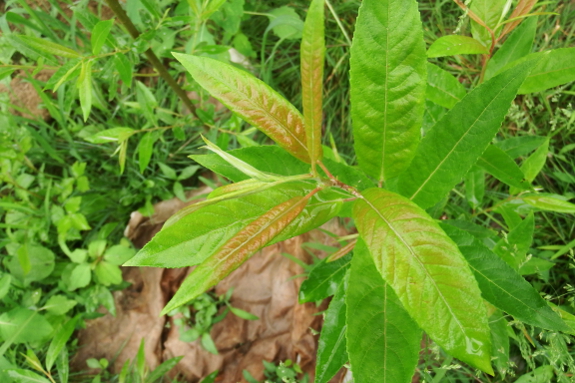
Meanwhile, the willow cuttings
I stuck into the ground near the mushroom area (in the wettest part of
our core homestead) all rooted with alacrity. They're growing so quickly
now that I probably need to start training them to one trunk so I can
begin to weave with the living wands. What fun!
We used the rest of our new fancy
weed barrier material on
high density apples.
It should last until 2027.
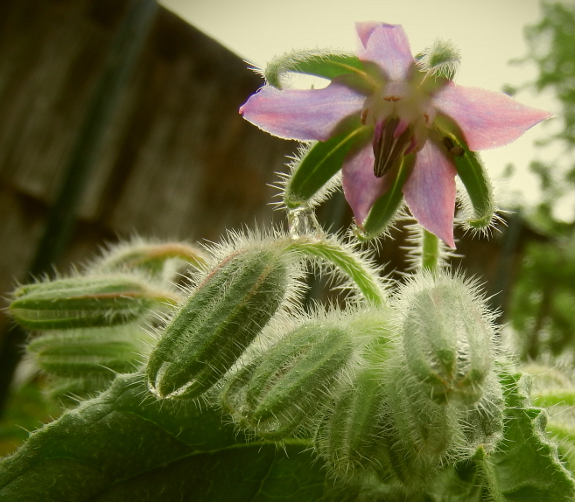
It's time for another
update on this year's mulch experiments! And, since I know many of you
only drop by for the photos and will be disappointed by what follows,
here's a pretty borage flower to start your day off right.
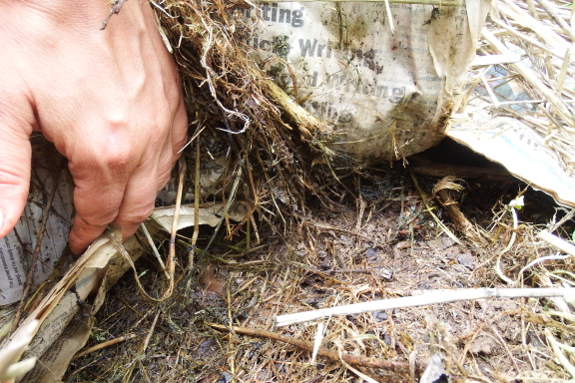
Okay, back to the point. A couple of weeks ago, I posted about several quick no-till garden prep options I'm trying out this year (shown below in a photo taken in the mid May). The time came to plant into the first round of beds this week --- one that was solarized
and then covered with goat bedding for two weeks, one that was
solarized and then left bare for two weeks, and one that was treated to a
kill mulch of newspaper topped with goat bedding. All had received
their initial treatment at about the same time, around six weeks ago.
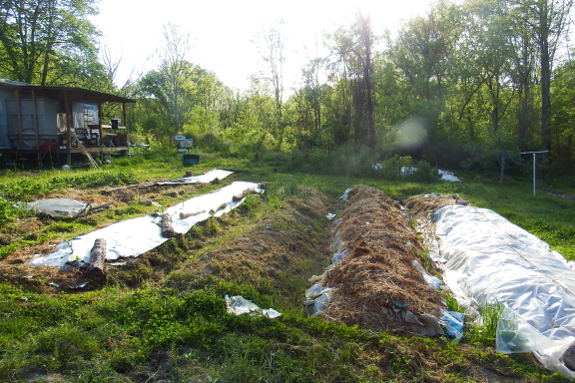 I
have a bias against solarization, so I was prepared to be annoyed by
those beds. However, the bed that was solarized and then immediately
treated with a topdressing of goat manure/straw was home to the most
worms of all treatments. Second best was the kill mulched bed,
suggesting that the manurey bedding was what attracted the worms in both
cases. Presumably the newspaper barrier in the kill mulched bed slowed
down the worm-attracting powers of the manure, although the paper did
make that bed ultra-easy to prepare for planting since there were no
weeds present after only a few weeks of kill mulching.
I
have a bias against solarization, so I was prepared to be annoyed by
those beds. However, the bed that was solarized and then immediately
treated with a topdressing of goat manure/straw was home to the most
worms of all treatments. Second best was the kill mulched bed,
suggesting that the manurey bedding was what attracted the worms in both
cases. Presumably the newspaper barrier in the kill mulched bed slowed
down the worm-attracting powers of the manure, although the paper did
make that bed ultra-easy to prepare for planting since there were no
weeds present after only a few weeks of kill mulching.
After digging in the dirt, my least favorite bed was the one that had been solarized and then left bare. My goal there was to keep the nitrogen levels in that bed to a minimum so my green beans wouldn't attract as many bad bugs,
but the short-term result was that a lot of warm-season grasses
sprouted under the heating effects of the solarization and I had to do a
lot of handweeding before planting. Worms were also absent from the top
few inches of that bed. So I think that these quick fixes really should
be paired with a yummy source of organic matter like compost or manure
if you want to keep your microorganisms happy.
I've got more to tell you
about experimental mulches, but this post got too long. So stay tuned
for another round of information tomorrow!
Half our bees decided to
swarm away yesterday after lunch.
A little too high up in a
tree to safely capture the queen, but luck was on our side and it
rained enough to make them go back home.
Now we have to figure out how
to split the hive before they take off again.
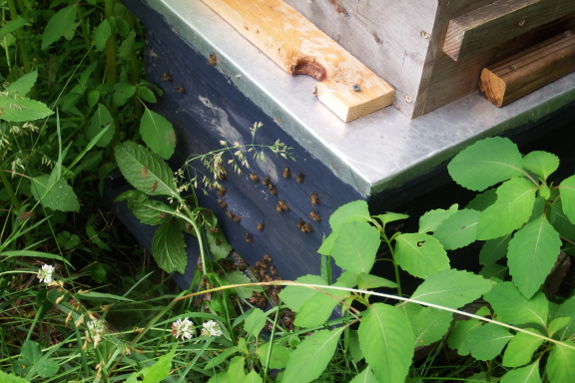
The swarm
lifted out of our hive at around 2 pm on Tuesday. It wasn't swarming
weather, though. By the time the cluster had formed around a branch high
in a box-elder tree, rain was coming down fast and it continued to rain
for the rest of the day.
I
sat on the back porch and watched the swarm for that entire time
period, but I still wasn't quite able to see what happened between
raindrops. However, I'm pretty sure I would have seen and heard if the
swarm flew away en masse --- noticing their roar from the back porch was
how I was alerted to the swarm in the first place, after all.
My best guess is that the swarm settled back down into the hive soon
after it started to rain. This suspicion arose when I went to check the
hive out around 4:30 pm and saw bees fanning a lemony odor into the
entrance, which is what swarms do to attract stragglers once they find a
new home. To confirm, I pushed my ear up against the boxes and heard a
roar just as loud (or louder) than usual. Yes, I was 80% sure the swarm
had gone back home.
Unfortunately, we didn't bait any swarm traps this year. So chances were pretty good that if the swarm left, it would disappear into the ether like our first one did. Not wanting to lose half of the hive's productivity for the year, I opted instead to beg them to stay.
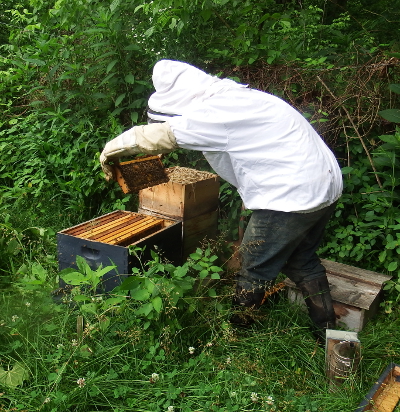 "Beg them to stay?" you say. "What in the world are you talking about?" Well, a hive split can sometimes prevent an incipient swarm,
especially if the queen ends up in one hive and the queen cells (which
will soon hatch into new queens) end up in the other. The best way to
ensure this happens is to go through frame by frame in search of both
the queen and the queen cells, but a Warre hive isn't set up for
fine-scale manipulation. So Mark and I instead opted to simply split the
hive as best we could and hope we'd get lucky.
"Beg them to stay?" you say. "What in the world are you talking about?" Well, a hive split can sometimes prevent an incipient swarm,
especially if the queen ends up in one hive and the queen cells (which
will soon hatch into new queens) end up in the other. The best way to
ensure this happens is to go through frame by frame in search of both
the queen and the queen cells, but a Warre hive isn't set up for
fine-scale manipulation. So Mark and I instead opted to simply split the
hive as best we could and hope we'd get lucky.
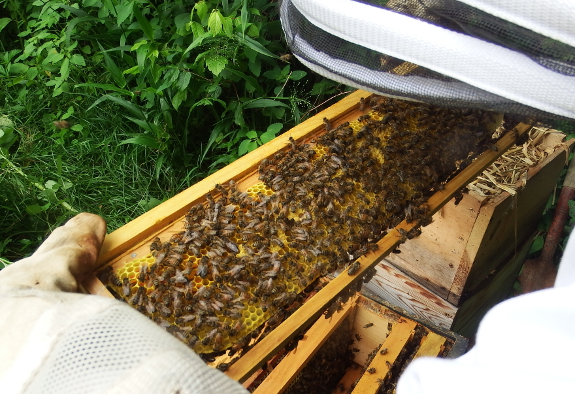
When I first saw this year's swarm, I suspected that our Warre-to-Langstroth converter
had been a failure. Why else would the bees swarm if they had two empty
boxes to build into? However, after removing the Warre half of the hive
and placing it on a piece of plywood to keep buzz-bys to a minimum, I
found that the top Langstroth box was entirely full of drawn comb neatly
packed with honey and pollen! In other words, the converter was a
resounding success.
Now that I do the math,
though, I realize that I probably waited until too late in the spring to
add more space. If there are queen cells about to hatch in the hive
right now, then their eggs would have been laid in the first week of
May...and we didn't put our converter in place until May 7. Next year,
we clearly need to add more space to our hive in April, especially if we
treat the bees to a bit of early spring feeding.
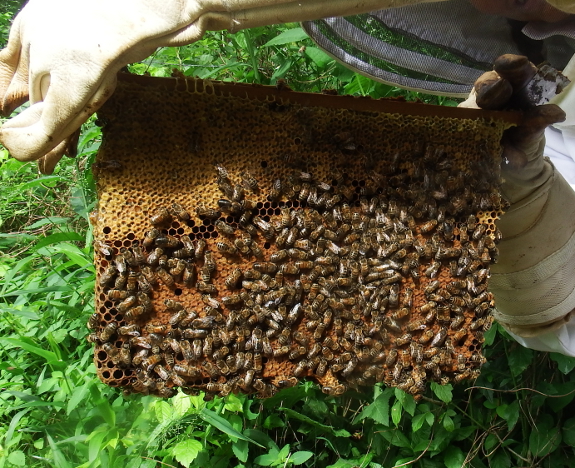
Unfortunately, there was
no brood in the Langstroth box. My hope had been that I could split the
hive at the converter, ending up with one Langstroth hive and one Warre
hive. But bees don't stay in a hive with no brood, so I had to instead
leave the converter in place and divvy up the two Warre boxes between
the two hives.
Best-case scenario, the queen will be in one hive and the queen cells in
the other, and both will be ready for business as usual shortly.
Worst-case scenario, hopefully there will at least be eggs in each hive
that will allow the workers to make a new queen if all of the current
monarchs end up stuffed together. In that worst-case scenario, we'd
probably still see a swarm within the next few days, so I'll likely know
one way or another pretty soon.
So now we have one
Warre/Langstroth hybrid and one Warre hive and are crossing our fingers
that they both take. Mark thinks he might be able to rig a way to set
Warre frames inside a Langstroth hive so we can convert the other hive
over to Langstroth with a shortcut method, and I'm looking forward to
the basswood flowers opening on our tree soon, so there's lots of buzz to come in the apiary. Stay tuned!

We decided to put the
mushroom station on the same waterline as the new tomato drip
irrigation so we could use this mechanical
hose timer to automate
all the soaking times.
It works like an egg timer so
it doesn't need batteries and comes in 5 other rainbow colors if you
don't mind paying a little extra.
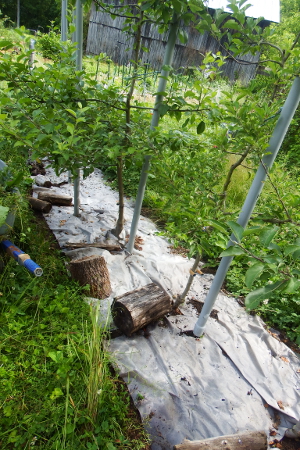 A
couple of our experiments this spring have focused on trying out new
methods of mulching around our perennials, and I thought it was time to
give you an update on my successes and failures. I've never been
entirely pleased with my mulch campaign in our berry and high-density
tree rows because I never have enough of my favorite mulch --- rotted wood chips --- to go around. For the last couple of years, I've instead mulched these guys with bedding from our chicken coops, but that material rots down pretty fast, is really too nitrogen-rich for woody perennials, and would be better used in the vegetable garden. Time to try something new!
A
couple of our experiments this spring have focused on trying out new
methods of mulching around our perennials, and I thought it was time to
give you an update on my successes and failures. I've never been
entirely pleased with my mulch campaign in our berry and high-density
tree rows because I never have enough of my favorite mulch --- rotted wood chips --- to go around. For the last couple of years, I've instead mulched these guys with bedding from our chicken coops, but that material rots down pretty fast, is really too nitrogen-rich for woody perennials, and would be better used in the vegetable garden. Time to try something new!
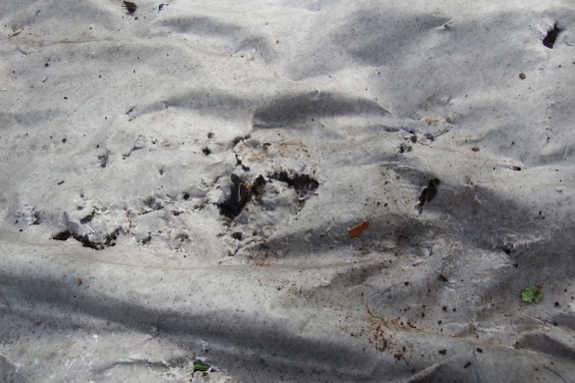
First of all, the roll of paper mulch we tried around our high-density apples
has now been marked down as an official failure. Don't get me wrong ---
the paper held back weeds very well (as long as the beds started out
weed free). But the paper only lasted about six weeks before it
developed big holes, even where no pets walked across the garden beds.
With a price tag equivalent to covering this area with a healthy layer
of straw (a mulch that would have lasted much longer while adding a lot
more organic matter to the soil), I don't think we'll be trying rolls of
paper again.
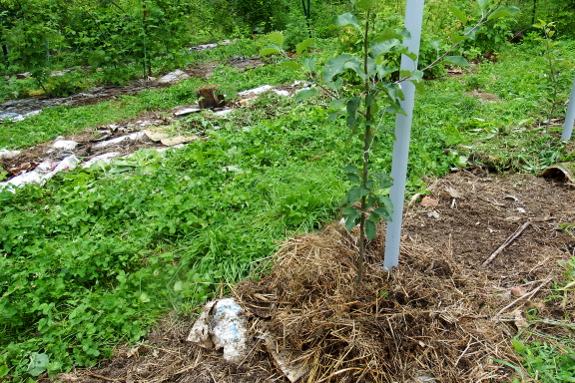
On the other hand, I'm
falling more and more in love with using plain old flattened cardboard
boxes around our woody perennials. I'd never laid down cardboard with
nothing on top before, so I've been surprised by how well the cardboard
stands up to the weather while also making the soil underneath loose,
damp, and happy. For example, the apple row in the foreground of the
photo above was treated to a layer of cardboard last fall, which has
since rotted enough that I had to double up the layers around the fruit
trees. But that left happy, bare soil behind where tree roots haven't
yet colonized the soil, so I scattered on some buckwheat and I suspect
we'll be good to go for quite a while. One layer of cardboard lasting
perhaps all year is a pretty good deal!
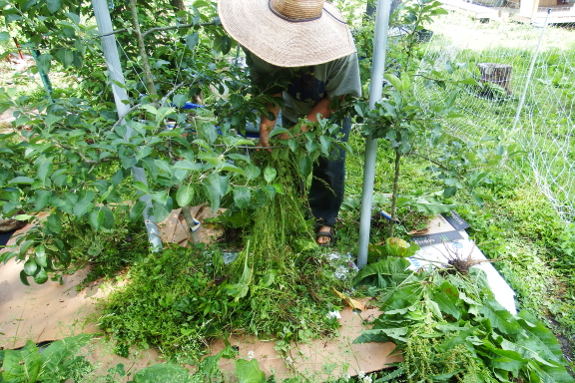
The straw-like substance
on top of the cardboard in my previous photo is simply garden weeds that
I had piled up nearby. Cardboard does
require some sort of object on top to weigh it down, so my new method
involves a quick weed of the biggest plants in the area I'm planning to
mulch with cardboard, followed by a layer of cardboard topped off with a
sprinkling of the weeds just pulled. The cardboard barrier prevents
weed roots from recolonizing the soil, and the dying weeds hold the
cardboard down until it melds with the soil. Just don't do this with
creeping plants (certain grasses, ground ivy, etc.), or you'll end up
with a weed problem on top of your mulch.
I suspect my slapdash cardboard mulches wouldn't fly in a city garden.
But if you live out in the country (and have a city person to collect
cardboard boxes from the side of the road for you --- thanks, Mom!), I
highly recommend that you give this perennial mulching option a shot.
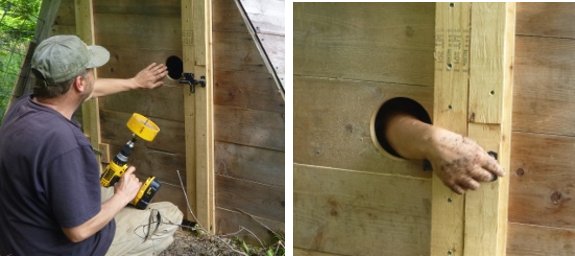
Latching our latest goat door
on both sides was a design flaw.
Sometimes Anna would have to
go all the way around if she didn't remember which side was latched.
A 4
inch hole saw made a clean looking access hole that solved the
problem.
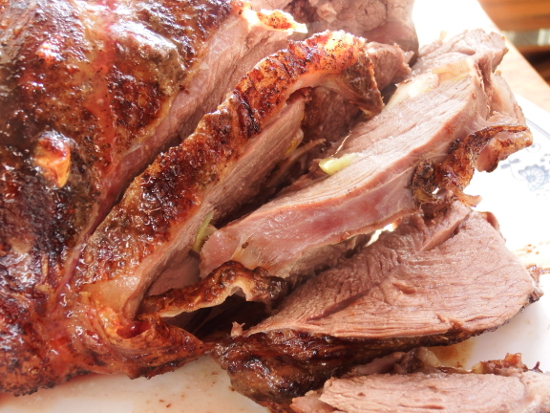
Embedding garlic and thyme directly in the flesh of a leg of lamb imbues
the meat with rich flavors. This recipe is perfect for a special
occasion when you need to feed the masses, or simply as a way to prepare
a week of meat for a family of two. We've even repeated this recipe
using a venison haunch, which was nearly as delectable as the lamb,
although the venison needed to cook a bit longer.
As a side note, I should mention that the juices that result from this
dish are almost too good to waste. In the winter, I usually roast root
vegetables at the base of the meat to soak up the fats, but for a summer
dish, the juices might be better saved to make a gravy. Whatever you do, don't throw them away!
Ingredients:
3 cloves of garlic
1 tablespoon of fresh thyme
2 tablespoons of olive oil
salt and black pepper
Start by bringing the leg of lamb to room temperature three hours before
you want to begin cooking. As the lamb warms up, make about 15 slices
evenly spaced around all sides of the hunk of meat, then push a sliver of
garlic and a sprig of thyme into each gap. Drizzle olive oil over the
lamb and liberally sprinkle on salt and pepper.
After the leg of lamb is warm, preheat the oven to 425 degrees
Fahrenheit and place the prepared lamb in a roasting pan. Bake for half
an hour, basting with the accumulated juices after fifteen minutes, then
turn down the heat to 325.
Continue basting every fifteen minutes, baking until the internal
temperature of the meat has attained 140 degrees Fahrenheit. Total cook
time for a 4-pound leg of lamb (including the initial half hour at a
higher temperature) should be about 1 hour and 50 minutes.
When the lamb is done, remove the pan from the heat and allow the meat
to sit for ten to fifteen minutes before carving. Serves 12.
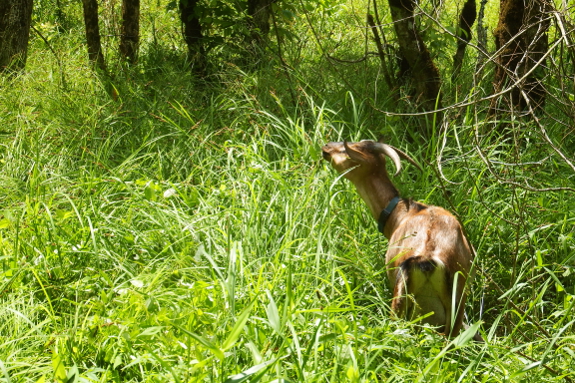
I read a lot about forest
succession during my misspent youth. But only after spending an hour a
day down in the floodplain with the goats have I realized that our very
own farm is home to a sister ecological process --- swamp succession.
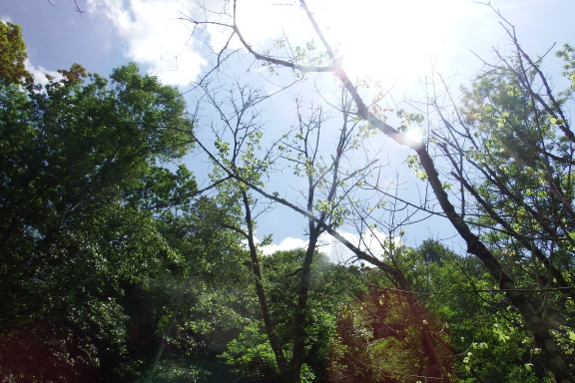
Yes, our floodplain looks
very different now than it did last year at this time. Part of the
change is due to dead and dying box-elders and walnuts, leaving only ash
and elm trees to thrive in soil that was simply too waterlogged for
most of the winter to allow root breathing room. Fewer trees means more
light on the floodplain floor, which in turn means lots more herbaceous
growth for the goats to enjoy.
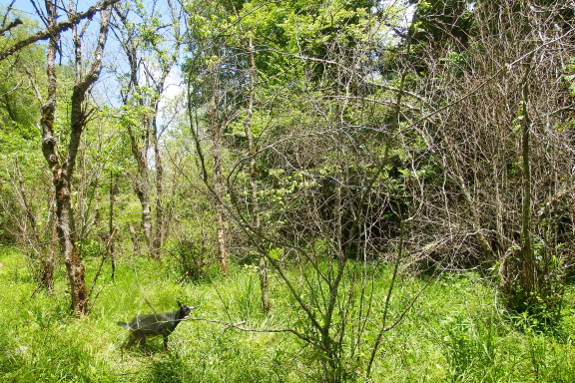
Another major shift
became visible this spring when most of our spicebushes failed to leaf
out. This could be a waterlogging problem as well. But since I've seen
dead spicebushes in the woods this spring, I suspect the issue instead
was caused by last winter's deep freeze.
Spicebush and sassafras are both tropical plants that moved north from
their Central American strongholds a long time ago. Will we lose these
odiferous denizens of the forest as our winters become more harsh? For
now, the bushes are sprouting back from the roots, but who knows how
many similar winters it would take to kill them dead.
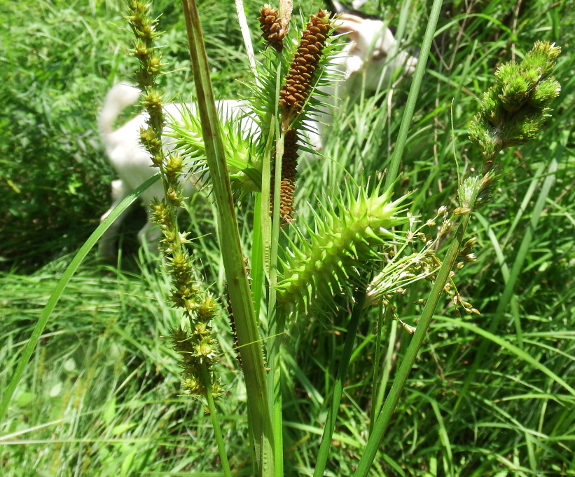
The thing about ecology
is that change is neither bad nor good. Change is simply...change. The
sunny, wet forest floor is now home to dense stands of sedges, which are
mostly ignored by the goats in favor of Canada moonseed, hog-peanut,
multiflora rose, and various tree leaves. But once Abigail's belly is
95% of the way full, she'll spend as long as I'll let her picking the brown
sedge seeds in the middle of the photo above off their plants. These are
the only grains our doe gets in her diet, and she tells me they are
delicious.
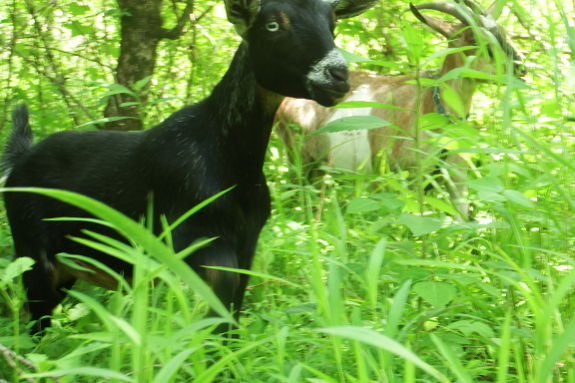
This part of the
floodplain was open pasture/hay field about fifty years ago, and I can
see how that would be a good use for the land now too. In the absence of
heavy machinery, though, the goats and I simply go down to frolic
whenever I have a spare hour to "waste." I lie atop the swamp bridge or unroll a yoga mat further out under the trees, and our herd grazes happily as long as I'll let them.
Then I call Artemesia's
name, or chant "Let's go, girls!" (yes, Lamb Chop is an honorary girl),
and all three come running. I no longer even bother to grab Abigail's
leash, but instead let our herd queen lead the way to the back door of
the starplate coop, where I finally assert my dominance by shutting them
all in. I like to pretend I've trained our goats to obey my
commands...but sometimes I think they've instead trained me to spend my evenings relaxing in the floodplain and looking at the trees.
Our old friend the cabbage worm showed up this week about a week behind the first White Moth sighting.
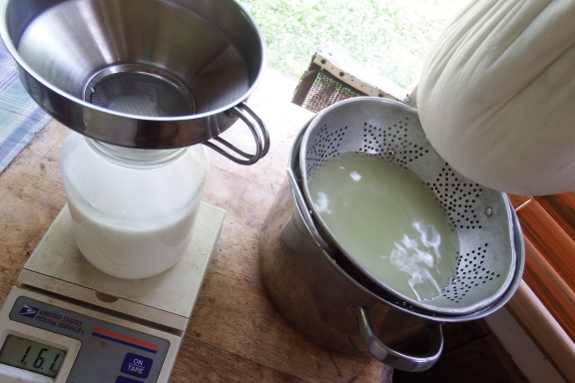
With my recipe perfected at last,
it started making sense to freeze our excess milk in preparation for a
big batch of chevre. Two weeks and twenty-three cups later, I thawed the
milk out in the fridge (and on the counter for the last couple of
hours) and then whipped up the big cheese.
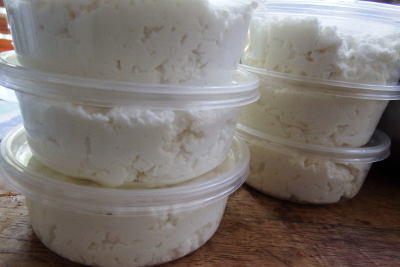 It
looks like each quart of milk gives me about a cup of goat cheese...and
a big batch is just as delicious as a small one! Five of those cups of
chevre will go back in the freezer for the winter and the sixth cup will
go into our bellies ASAP. (No, really --- I barely managed to put the
lid on the container long enough to write this post.)
It
looks like each quart of milk gives me about a cup of goat cheese...and
a big batch is just as delicious as a small one! Five of those cups of
chevre will go back in the freezer for the winter and the sixth cup will
go into our bellies ASAP. (No, really --- I barely managed to put the
lid on the container long enough to write this post.)
What's up next? Dr. Fankhauser's cheese tutorial
suggests a basic pressed cheese or American mozarella, while my milking
trainer instead recommends trying feta with the lipase she's giving
when we pick up our annual lambs.
Since we haven't yet rigged a cheese press, we'll probably try the feta
or mozarella next, but I'm open to suggestions. What do you recommend
as an easy beginner cheese?
We got almost three years out
of our cheap tarp that covers the straw before it started to get thin
and holey.
Turns out we could have saved 5
dollars on today's new
tarp if we would've bought it on Amazon compared to our local feed
store.
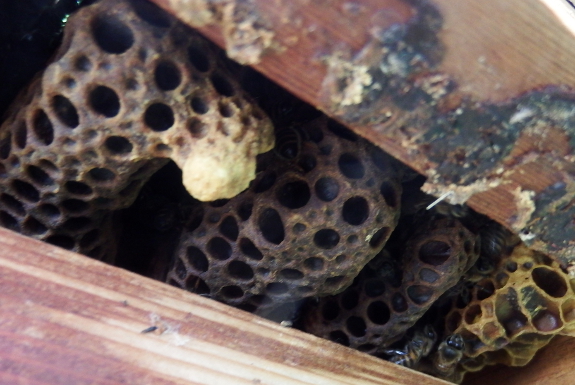
In my last bee post, I explained how I split our hive in an attempt to prevent a swarm.
However, due to the less-then-movable frames in our Warre hive, I
wasn't sure where the queen had ended up and whether the other hive had
the potential to make a queen of their own.
So, five days later, I
decided to take another peek inside each hive. What I found was
reassuring. In the old hive (not pictured), I was able to wiggle one
frame loose in the middle of the brood chamber and found a few eggs.
Since honeybee eggs hatch out into larvae three to four days after being
laid, this is proof that I have a laying queen --- almost certainly the
original queen --- in the old hive.
The other hive resisted
my efforts to pry loose a frame without unduly tearing the comb. So I
had to take another approach to hunting for queens inside that hive.
Assuming the old 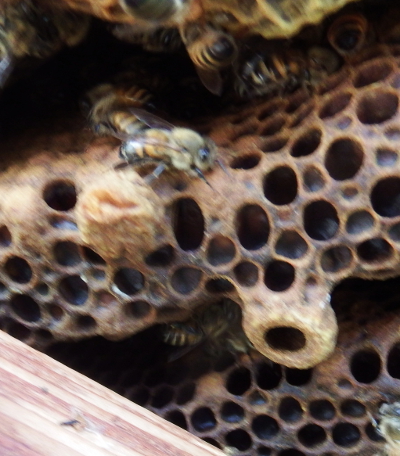 queen
was in the old hive, my best chance for this hive would be if queen
cells were present and ready to hatch into new queens. Luckily, queen
cells often show up on the bottoms of frames, so they're relatively easy
to hunt for by simply sliding the box over to the edge of the hive and
peering up underneath.
queen
was in the old hive, my best chance for this hive would be if queen
cells were present and ready to hatch into new queens. Luckily, queen
cells often show up on the bottoms of frames, so they're relatively easy
to hunt for by simply sliding the box over to the edge of the hive and
peering up underneath.
Sure enough, a peek up
through the bottom of our new hive's brood box showed both hatched and
unhatched queen cells. Since this hive will have to wait about three
weeks for the virgin queen to mate and then begin to lay, it's a good
thing I accidentally included most of the capped honey in this hive. In
the meantime, it might be a smart idea for me to feed the daughter hive
since nearly all of the foraging workers stayed with the mother
hive and there will continue to be fewer workers present in the daughter
until the new queen begins to lay.
So it looks like luck was
with me --- I have two queen-right hives and the mother hive still has
the potential to sock away a lot of honey this year since she didn't
lose as many workers as she would have during a swarm. I guess it's a
good thing my honeybee purchases fell through this spring after all
since I ended up doubling the number of hives in my apiary the
old-fashioned way!
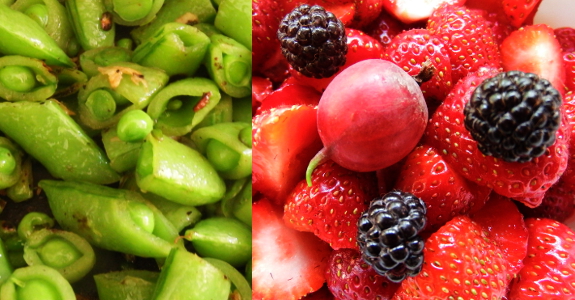
Raspberries are waxing, strawberries are waning.
An in-season menu keeps our taste buds hopping.
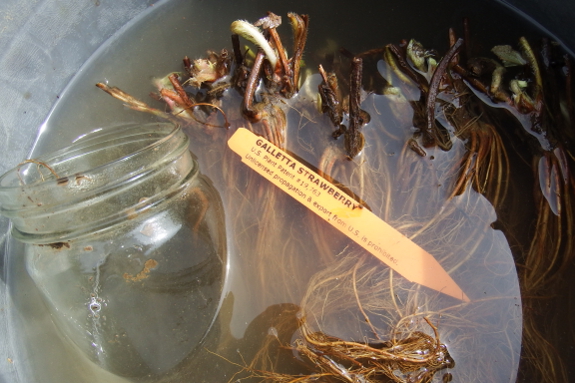
We love fresh strawberries, so we plant a range of varieties
to extend the harvest season. Galletta is a bit of a gamble in that
regard --- the plants might give us an extra week of strawberries very
early in the season...or they might bloom so prematurely that we're
unable to prevent freeze damage.
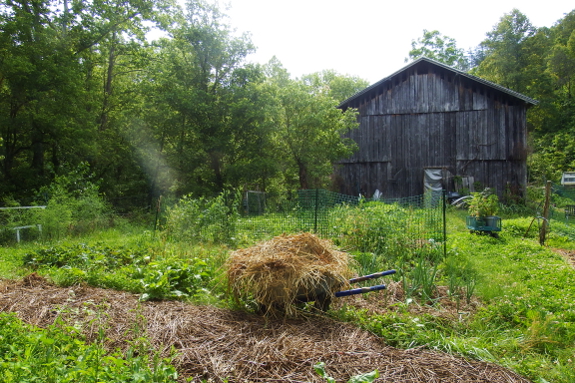
Planting location for an
ultra-early variety like this depends on how much we're willing to risk.
Should we plant in the sunniest part of the garden, ensuring blooms a
week before strawberry flowers open up in the shade of our hillside (and
resulting in similarly early strawberries)? Or should we plant in the
colder part of the garden to retard flowers that will get nipped by late
frosts?
I decided to live large
and set out our Galletta strawberries in the sunny mule garden. But I
hedged my bets by placing them all together in one raised bed that will
be easy to cover with quick hoops or other frost-protection. Here's
hoping I won't regret taking the high-risk approach to early
strawberries!
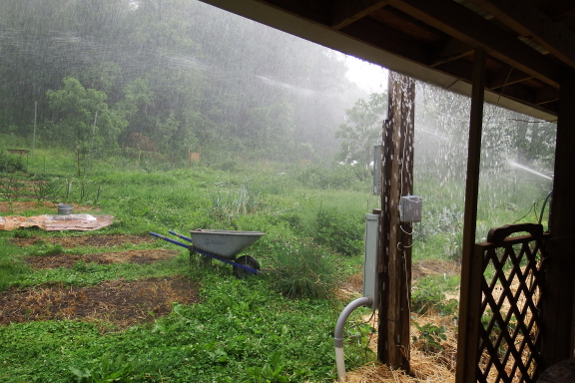
But after we soaked each part of the garden Monday, Texas finally gave us back our rain.
One inch of wild-harvested water should keep most garden plants happy for a week. Time to turn off the sprinklers.
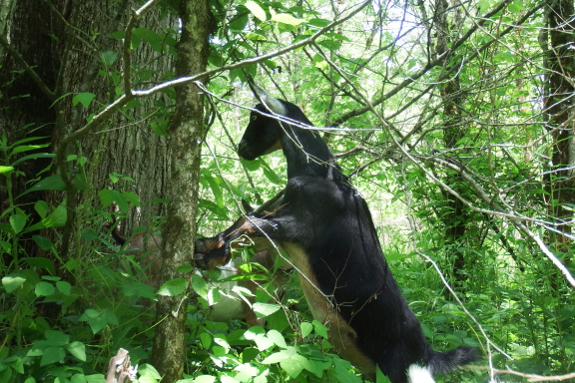
Writers are fond of
telling new goat-keepers that our herds are browsers, not grazers. In
other words, goats are supposed to crave tree leaves. But do they
really?
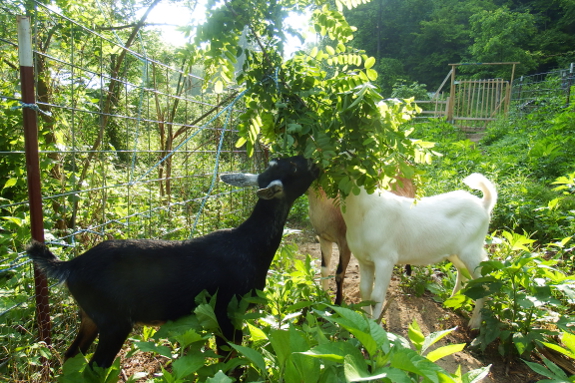
Watching our goats graze,
my answer is --- sometimes yes, sometimes no. If given a choice between
a lush stand of vegetatively growing oats and nearly all tree leaves,
Abigail makes a beeline for the oats. On the other hand, black locust
leaves always hit the spot over vegetation on the ground.
In the end it seems to
come down to succulence, protein, and energy content. Even though goats
are ruminants, their bellies are relatively small compared to those of
cows. And milk production uses up a lot of calories. So a milking doe
like Abigail needs to choose plants of optimal nutrition, which seems to
consist of honeysuckle, multiflora rose, black locust leaves, spring
grass, and oats. She'll eat tidbits of lots of other plants, but those
few offerings seem to make up the bulk of her diet when I allow it.
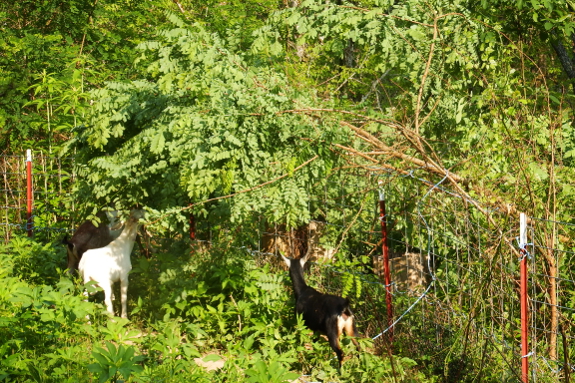
In the summer and with
insufficient pastures, black locust is the easiest high-quality leaf
matter to wrangle for our goats. Luckily, our herd's pastures are
located in subpar soil, which is the preferred habitat of this
nitrogen-fixing tree.
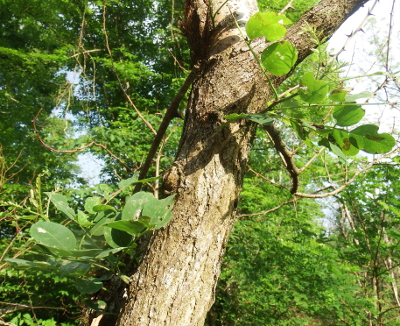
The trouble is, my current method of cutting one large limb a day for our herd isn't a long-term strategy. Cut limbs do resprout
(as you can see to the right), but I suspect I can only get away with
coppicing a tree once or twice a year if I want it to survive.
On the other hand, goats have such sensitive mouths that they're able to pick off leaves
one at a time, leaving the thorny branches intact. Which makes me think
that if I plan it right, I might be able to bend branches down so
they're within nibbling reach, then let them bound back up 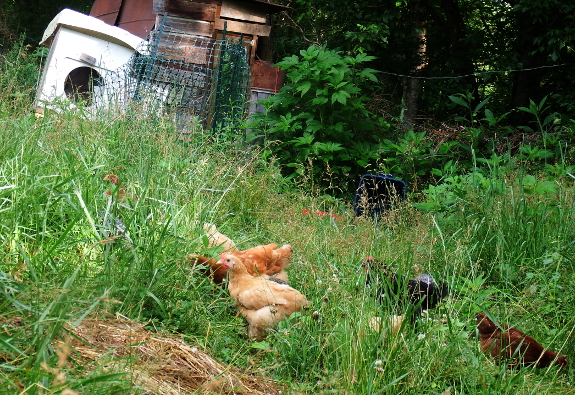 to
regrow. Or, since we rotate our pastures frequently, it's possible I
might get away with simply letting tree leaves regrow while the goats
are absent on limbs that are always within goat reach.
to
regrow. Or, since we rotate our pastures frequently, it's possible I
might get away with simply letting tree leaves regrow while the goats
are absent on limbs that are always within goat reach.
Plenty of fun observation
and experimentation ahead as we build the optimal goat pastures. What
fun! I almost miss the days before we figured out the best way to pasture chickens...but not quite.
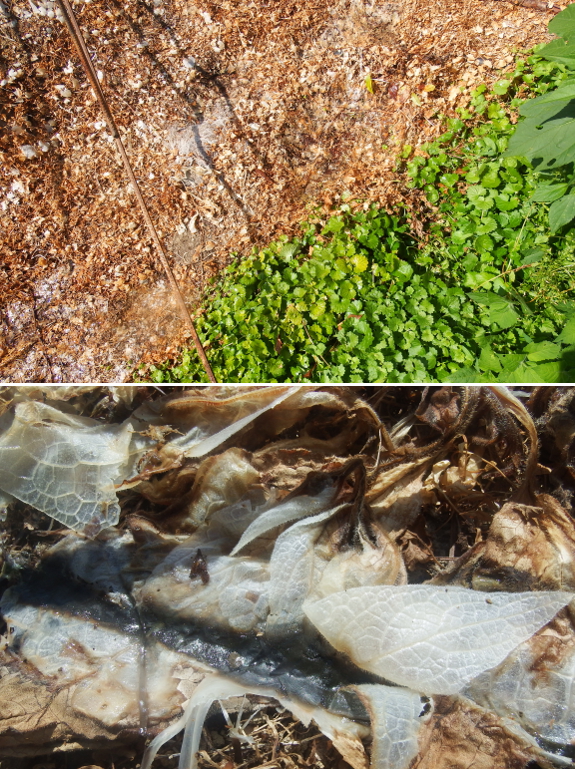
Solarization was effective at killing common garden annuals. But can the technique overcome difficult perennial weeds?
Two weeks with clear plastic
on top of a mass of ground ivy and comfrey turned the leaves crunchy.
Now the question is --- will the weeds regrow?
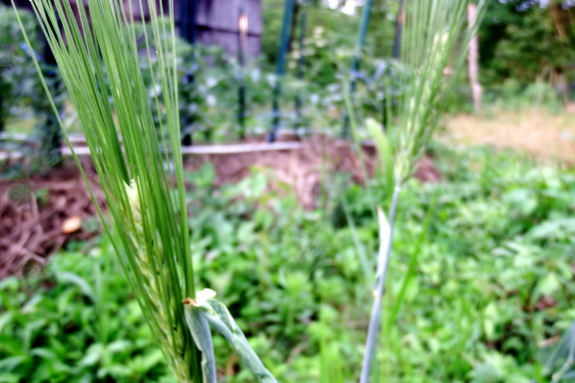
Preliminary results are trickling in from this year's cover-crop experiments.
I'll start with the least successful --- barley. Barley works fine as a
fall-planted cover crop, assuming you have a way to kill the
overwintering plants in the spring. And I'd read that you can also plant
barley in spring as an early ground cover that heads up in time to let
you plant summer vegetables afterwards. Unfortunately, I didn't give the
species a very good test.
The barley pictured above went into the bare soil of the forest garden aisles,
which had been dug down to near the level of the groundwater in order
to mound up the surrounding beds. But soon after planting in early
April, the aisles flooded and (I suspect) killed emerging seedlings.
After that, our weather took an extreme turn in the other direction and
turned hot and dry, making for bad spring-crop conditions.
I did plant another test
bed in the main garden, but, unfortunately, that bed fell prey to Mark's
weedeater. In his defense, baby barley looks just like grass. And I
hadn't done a good job of weeding that area yet this spring, so my
long-suffering husband wasn't entirely sure where the aisles ended and
the beds began. To cut a long story short --- most of the barley planted
there didn't manage to regrow and the bed instead went to weeds.
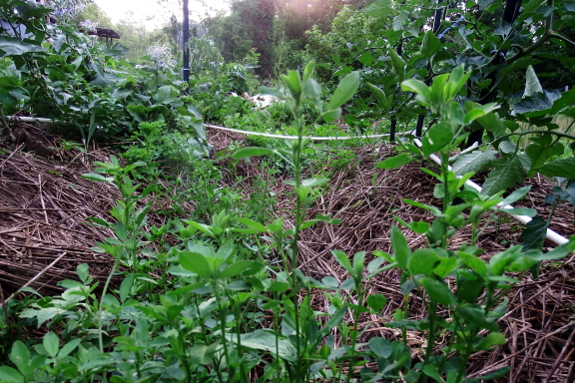
I planted alfalfa at
about the same time and in about the same place, but with more
trepidation. However, to my surprise, the legume turned out to be much
more hardy than the grain. The forest-garden aisle of alfalfa had to
deal with the same flooding-then-parching conditions, and the control
bed in the front garden also got accidentally mowed. But alfalfa in both
spots managed to resprout and make at least a moderate stand. In fact,
in areas where I planted alfalfa and protected them from the weedeater,
the cover crop nearly looks ready to be cut as a come-again mulch
producer. Not bad work for two months of growth!
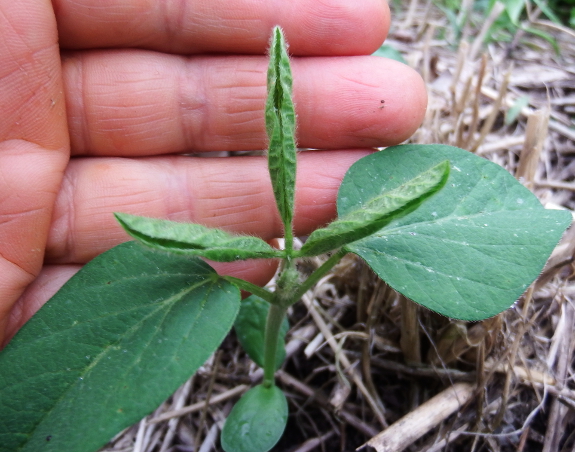
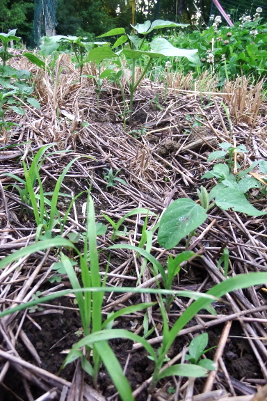 Legumes
are one of the themes of this summer as well. Sure, I largely depend on
animal manures to add nitrogen to our garden, but it never hurts to
have a vegetative source of the high-demand nutrient. So I'm trying out
soybeans in several locations ranging from rye stubble in prime soil
beds to the pure clay that has been recently solarized. I'll keep you posted about the results.
Legumes
are one of the themes of this summer as well. Sure, I largely depend on
animal manures to add nitrogen to our garden, but it never hurts to
have a vegetative source of the high-demand nutrient. So I'm trying out
soybeans in several locations ranging from rye stubble in prime soil
beds to the pure clay that has been recently solarized. I'll keep you posted about the results.
In the photo to the
right, you can actually see three different cover-crop species if you
look closely. In addition to soybeans and scarlet runner beans
(to train onto the trellis not visible above the picture), I also
interplanted both millet and sorghum-sudangrass in this bed. I'm not
sure whether the millet is actually coming up, but the
sorghum-sudangrass is growing, albeit slowly. More on these warm-season
grasses as the season progresses.
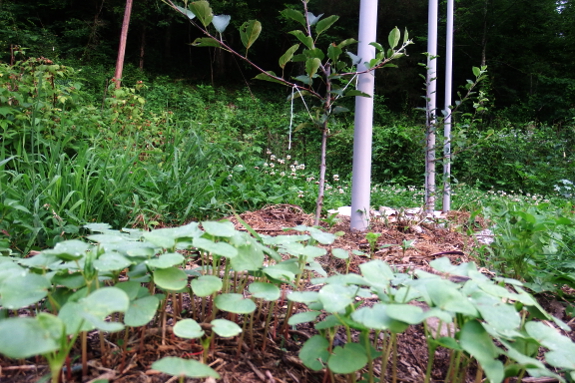
Finally, I'd be remiss if
I didn't mention my favorite summer cover crop, the old standby
buckwheat. This non-grassy grain managed to sprout despite our recent
drought and is pictured above filling in empty bed areas between young
apple trees. Honestly, I wouldn't be at all surprised if, after trying
six new species in 2015, I plant all buckwheat again next year. But stay
posted for updates as they come down the pike!
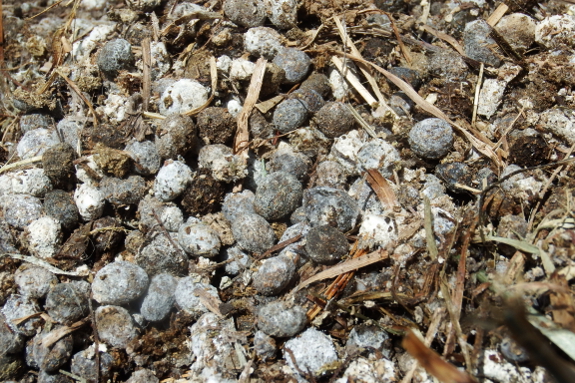
A friend gave us a couple of bags of rabbit manure to experiment with. (Thanks, Dennis!) Anna was ecstatic.
Some gardeners report that
rabbit pellets are cool enough to use close to plants pre-composting.
But if urine is mixed in and you can smell ammonia, even rabbit manure
can burn your plants.
We plan to topdress our new strawberry beds with manure, but to keep the pellets several inches away from young roots.
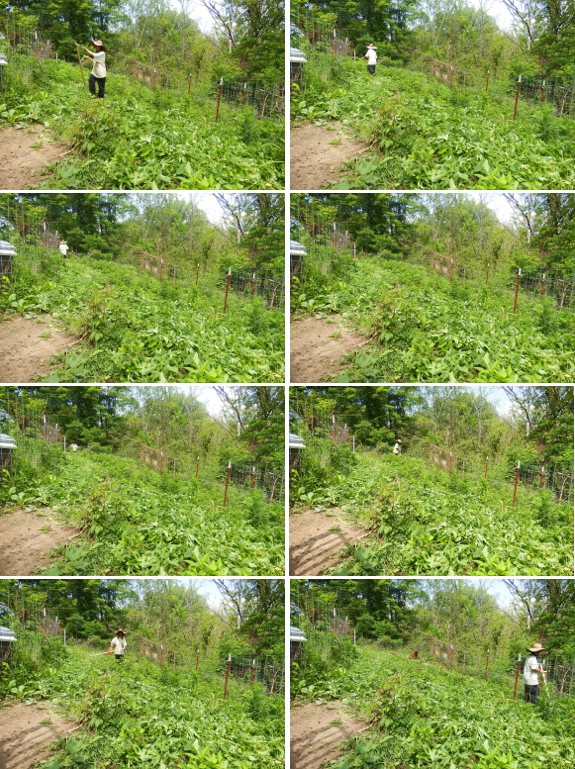
Did you ever wonder how long it takes to scythe
a field? The photos above were taken on a 60-second delay as I cut
ragweed growing up in one of our goat pastures. (Yes, our spoiled goats
turn up their noses at ragweed.)
I'm ashamed to admit that I hadn't put my scythe together in years prior to playing around up on the goat pasture Friday. Scything fills a similar niche to weedeating,
and it's always much easier to ask Mark to weedeat than to scythe
myself. But my favorite mechanically-minded husband was visiting his mom
in Ohio this past week, so I opted to do it myself rather than wait.
On a related note, I've
been wondering lately whether a better cutting tool for me wouldn't be a
sickle. I often find myself wanting a handheld cutter that can easily
be used to spot-weed dock coming up in the pasture or harvest clumps of
comfrey for the goats. A bit of research suggests that the top
contenders for that job are Japanese sickles (aka kamas) and European grass hooks. I'd love to hear it if you've had good or bad experiences with either!
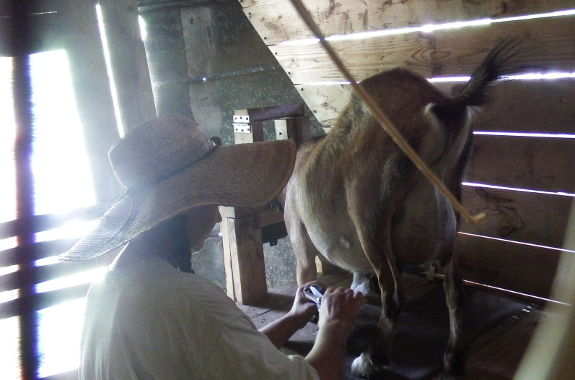
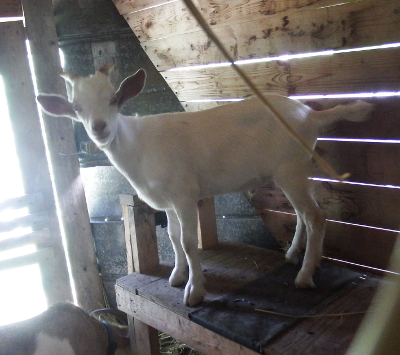 We let our goats' hooves
slide for six weeks recently instead of trimming them at the month
mark. The edges of Abigail's front hooves had just started to curve in,
but everything else looked fine.
We let our goats' hooves
slide for six weeks recently instead of trimming them at the month
mark. The edges of Abigail's front hooves had just started to curve in,
but everything else looked fine.
Lambchop didn't get trimmed this time around because his date with the butcher is only a week and a half away.
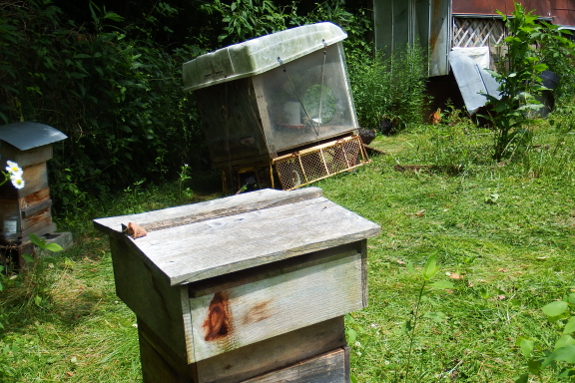
Ever since we split the bees and then dragged the brooder
into the apiary, the pasture in question has felt like a
mini-metropolis. Well, maybe not so mini. I estimate our two hives
together house perhaps 30,000 bees...about the size of my original home
town.
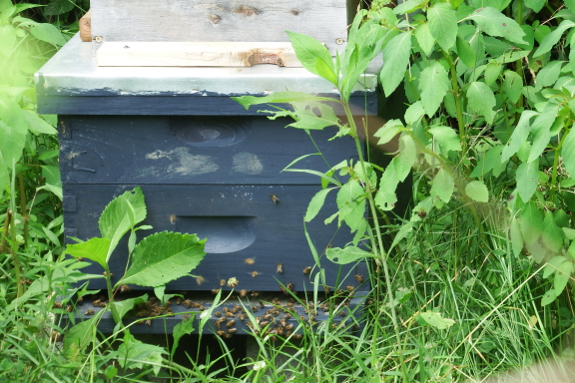
More seriously, the
foragers in the mother hive are working like crazy, even though the
basswood is still in the bud stage. In contrast, the daughter hive
appears to be doing nothing...until you peer closely and see workers
walking back and forth between hive and feeder, then tap the hive and
hear the roar. Some of those nurse bees should graduate into foragers
before too long, at which point the daughter hive will also be packing
away winter stores.
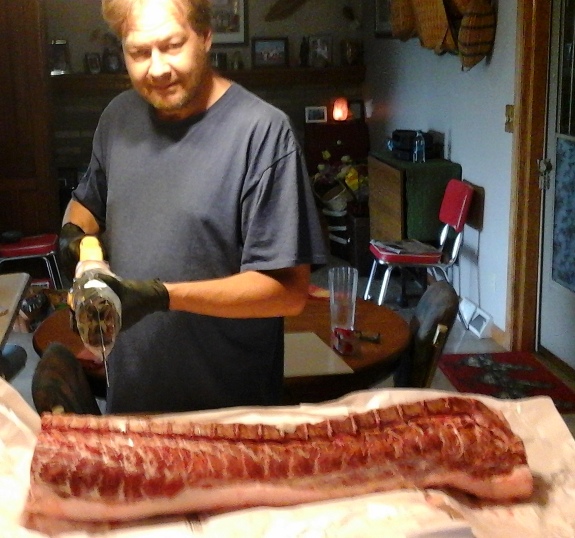
I helped my Mom cut up a
large piece of pork recently.
She taught me how to poke a
finishing blade through a ziplock bag to protect the saw and keep
things sterile.
It took us almost 2 hours to
work up the above slab into pork chops.
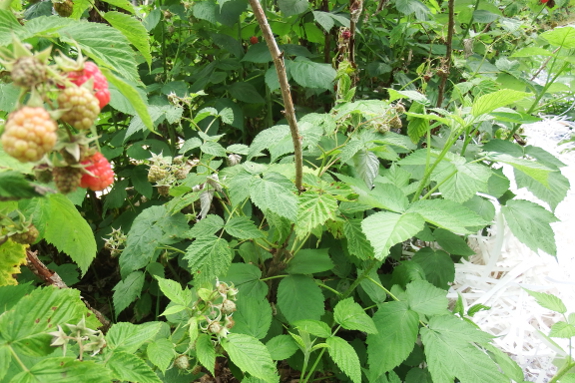
Our junk mail built up to fill its box at the same speed as last year, meaning that I had a big bin of shredded paper ready to hit the garden
once again in early June. I've decided that this windfall is best used
around the red raspberries, which are my hardest perennials to mulch
because canes come up in new spots every year. Shredded paper fills in
all the gaps nicely, and I only wish I had more of it.
Speaking of raspberries,
we're now harvesting a couple of cups a day of reds and blacks. Add that
to the broccoli and cabbages that need to be processed this week and
the cucumbers that are just getting ripe and we're eating well in the
middle of June!

Today begins the first day of
our big Amazon sale.
23 percent off a bucket
EZ Miser or 12 percent of an EZ
Miser kit that allows you to install 2 EZ Miser spouts on just
about any size container.
A big thanks to those who
took a minute to give us 5 stars and a nice review. We had a 1 star
review due to some leakage but didn't get a chance to make it right.
Sometimes a poultry nipple will get a small piece of dirt clogging the
nipple valve causing a leak and usually can be fixed by tapping the
nipple with your finger a few times. It's also possible that hard water
can leave calcium deposits on the valve. If that's the case soaking
with some vinegar can make it right.
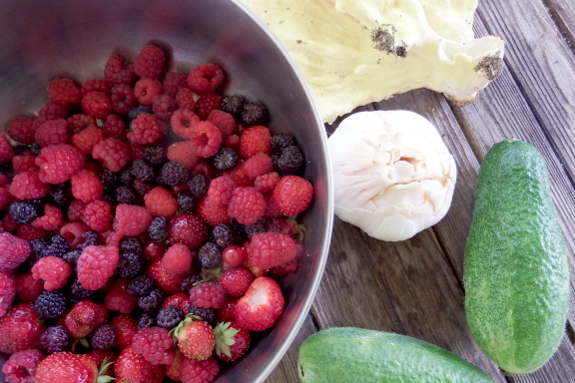
As Thoreau might say, I went to the woods in search of leaves for chicken-coop bedding and came home with a bright orange fungus as a bonus.
Okay, so Thoreau's quote
doesn't go quite like that. But what can be better than stumbling across
a choice edible within my usual stomping grounds?
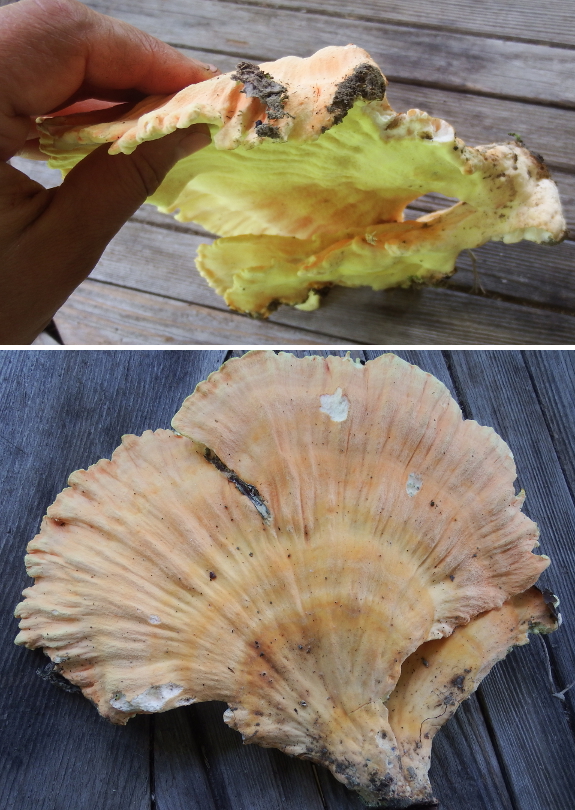
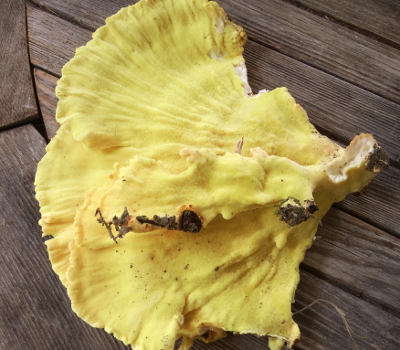 Actually,
I always get a little nervous when I bring home a wild mushroom species
I've never prepared before. Granted, chicken of the woods is relatively
easy to identify due to its bright yellow, gill-less (pored) underside,
so it's considered one of the hard-to-kill-yourself-with fungi. On the
other hand, even properly identified chicken of the woods can make some
people sick, especially if harvested from eucalyptus or conifers.
Luckily, our mushroom was sprouting out of the base of a dead red oak
and was quite young, making it less likely to irritate allergies.
Actually,
I always get a little nervous when I bring home a wild mushroom species
I've never prepared before. Granted, chicken of the woods is relatively
easy to identify due to its bright yellow, gill-less (pored) underside,
so it's considered one of the hard-to-kill-yourself-with fungi. On the
other hand, even properly identified chicken of the woods can make some
people sick, especially if harvested from eucalyptus or conifers.
Luckily, our mushroom was sprouting out of the base of a dead red oak
and was quite young, making it less likely to irritate allergies.
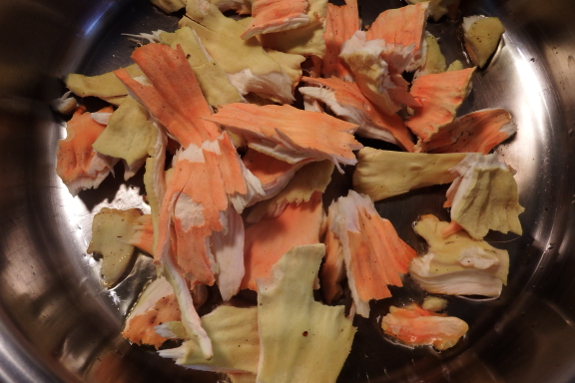
I sauted up the flesh in
oil with a clove of just-harvested garlic and some salt and pepper. Then
I teased our palates with just one piece of mushroom on each plate for
lunch in case we turned out to be allergic.
There were no negative reactions. Instead, we both found the taste to be
extraordinary, like a more richly flavored piece of chicken. I think
chicken of the woods just moved to the top of my favorite-mushrooms
list!
We now only grow one variety
of garlic called Music.
The yield is great but what
we like most is the resistance
to cold.
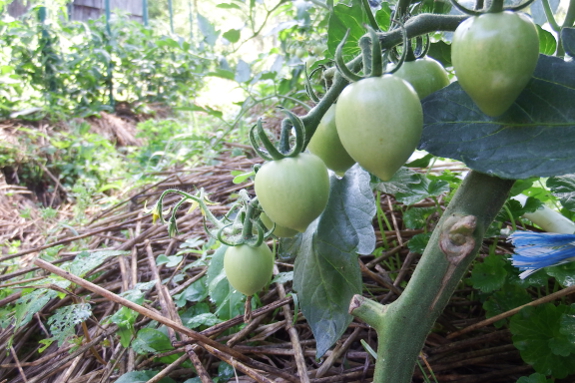
For the past three years,
by this part of June, I've been keeping secrets from my husband. I'd
come in for lunch on Mondays disgruntled and would dread walking down
the tomato row. That's right --- my weekly pruning sessions inevitably turned into a game of fight-the-blight.
It's been drier this
year, but based on neighborly reports, I think the real reason blight
has yet to hit our farm is because I paid the big bucks for blight-resistant tomato varieties.
I've been cutting off lower leaves so they don't drag on the ground,
but otherwise have nothing to do during my Monday sessions except tying
up stems that have grown a foot or more during the last week. Never mind
the eventual yield, those pricey seeds have already paid for themselves
in anti-depressant effect!
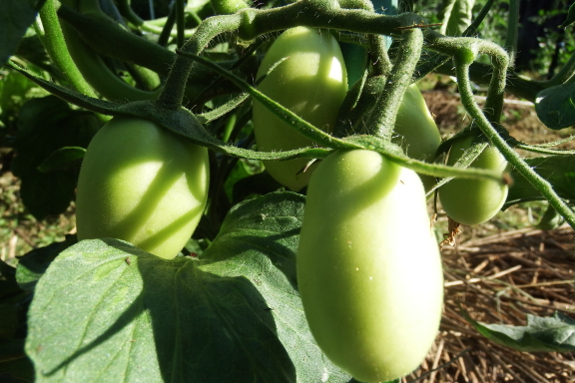
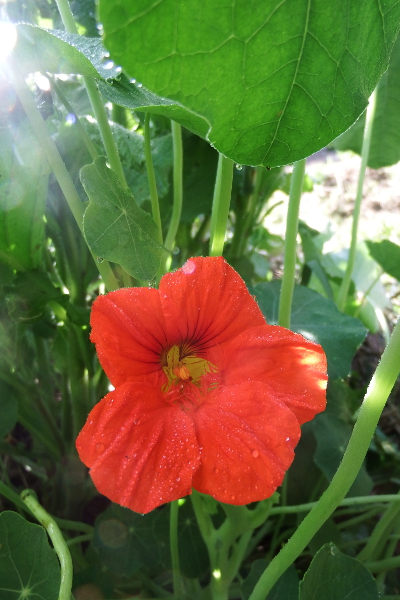 Most
of the new tomato varieties act just the way you'd expect, but Plum
Regal seems to be a little odd. I've grown determinate varieties before,
but none have topped out so short --- right around knee high. To keep
the plants growing, I've taken to leaving the suckers in place since the
main stem seems to have already achieved its preferred height.
Most
of the new tomato varieties act just the way you'd expect, but Plum
Regal seems to be a little odd. I've grown determinate varieties before,
but none have topped out so short --- right around knee high. To keep
the plants growing, I've taken to leaving the suckers in place since the
main stem seems to have already achieved its preferred height.
What's with the
nasturtium? It's just another burst of happiness in the tomato zone this
year! I planted our 2015 tomatoes in old hugelkultur beds, and one spot
contained relatively unrotted wood that made it hard to dig
tomato-planting holes. So I instead filled that gap with nasturtiums,
borage, zinnias, and chamomile. It's fun to have a colorful collection
of flowers in between two of my tomato plants!
Got a few more beds of garlic harvested today before it got too hot.
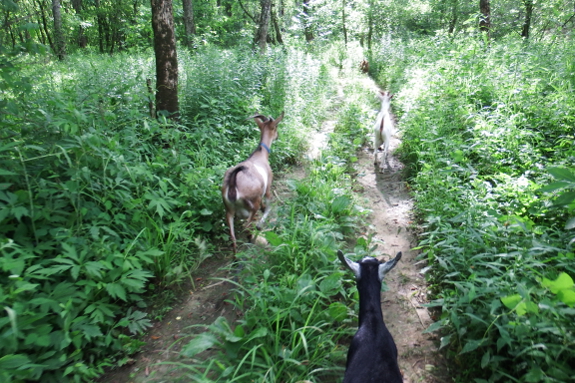
It's been blazing hot, with highs in the mid nineties. So, after supper, the goats and I head to the creek for a cool-down.

I jump in one of the deep
holes while the herd looks on in horror. Actually, on day one, all
three goats ran up and down the bank and cried, "Please get out! You'll
drown! Or the alligators will get you!" No matter how much I explained
that naming one of our wettest areas "the alligator swamp" was poetic
license, they wouldn't calm down.
On day two, Artemesia was
the only one worried about me, though. And by day three, the whole herd
just quietly grazed along the shore, although my favorite little
doeling did keep her eye on me the whole time. I guess it's handy to have a goat lifeguard, even if the water is less than waist deep.
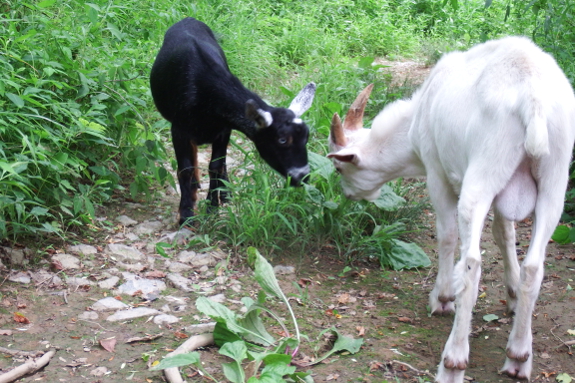
By the time my core body
temperature has cooled down sufficiently to make life enjoyable again,
the goats are deep into their grazing cycle. This week, they're spending
their days in our poorest pasture, which wasn't even grazed by chickens
last year and which runs out of goat-friendly greens after about day 1.
I want the goats to keep depositing manure there, though, so I bring
tree branches each morning and drop by with cabbage and carrot leaves
midday. Still, by dinner time, the goats are hungry.
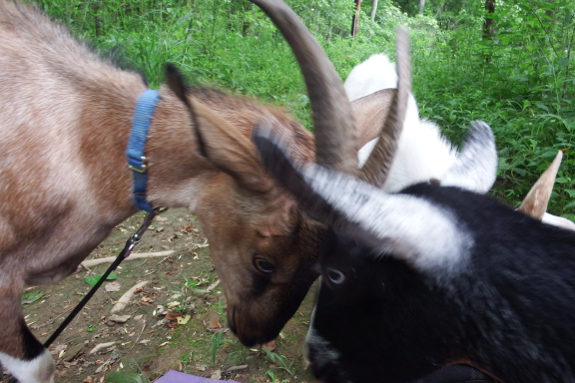
So I settle onto my yoga
mat with a book or a notebook (depending on my mood) and relax for an
hour or so. I know when each belly fills because the attached goat
drifts back to visit with me, and make trouble (Lamb Chop) or act cute
(Artemesia).
Of course, the herd isn't
ready to go home until the herd queen is 100% full. So when Abigail
makes an appearance and decides head butting is more fun than eating, I
pack up and we walk back down the driveway to our core homestead.
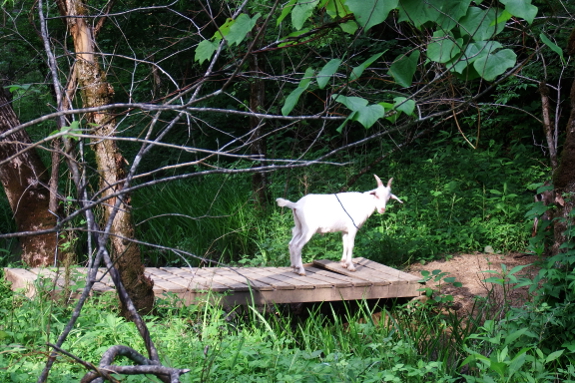
The goats scurry
alongside with little or no verbal prodding, Artemesia often right at
heel with her ears perked back to make sure I'm still coming. The other
goats are less concerned about a human's presence, so they just make a
beeline for the coop where the deer flies they've accumulated will be
confused and will soon fly away.
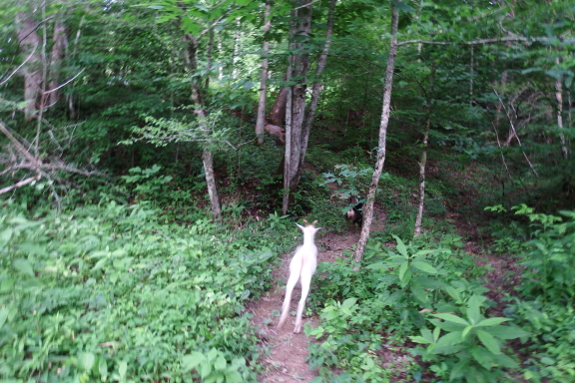
And that's my post-supper
goat hour in a nutshell. The only part I left
out is the frolicking leap of goats 1, 2, and 3 down the hill at the
beginning, during which time they really do appear to be clicking their
heels together in joy. I'm still working on catching that on camera, so
you'll just have to imagine goat glee at 6 pm today.
The last trouble we had with
the ATV was it not going into All Wheel Drive.
We took it into the local
mechanic and he figured out that the battery was too weak even though
it started up on the second try.
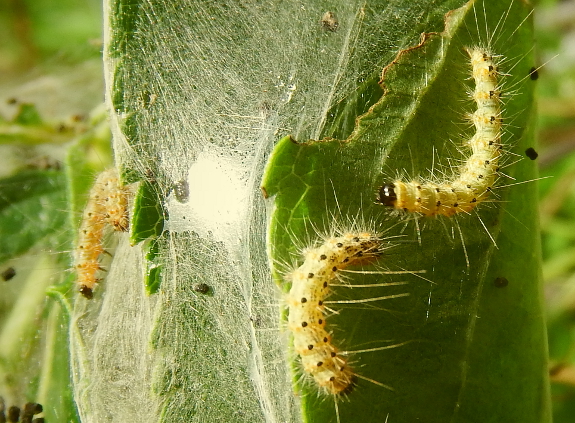
I haven't seen a single tent caterpillar this year, but the fall webworms (Hyphantria cunea) have come to visit our farm for the first time ever. I'm not glad to see them.
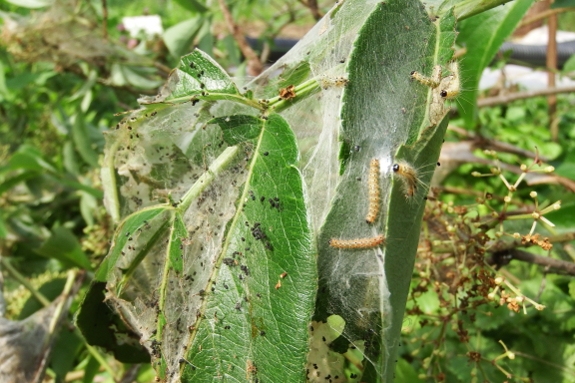
Like tent caterpillars,
webworms hatch out in large groups and then spin webs around themselves
to protect their tender bodies. Since predators can't easily get to the
caterpillars inside, the insects make short work of leaves within their
webs. In our yard, the webworms have invaded the red raspberries,
elderberries, pears, and hazels.
The good news is,
clipping off the affected limb and throwing it over the hill seems to do
a pretty good job of protecting the plant in question. So I guess
webworms are more of an annoyance than a scourge. They would have been
even less annoying if I hadn't waited two weeks to identify and deal
with them, afraid that a new and terrifying invasive had come to call!
We had a problem today with
some aggressive hornets on a pear
tree.
There was a short debate on
who would suit up and move the nest.
Anna wanted to do it but I
had to pull the Head of the Household card and asked her to take
pictures from a safe distance while I snipped the problem limb and threw
the whole thing over a hillside.
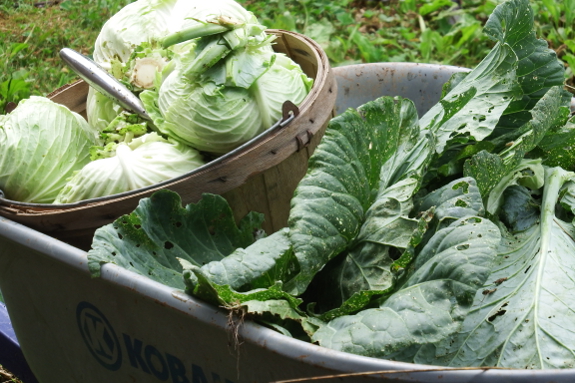
We harvested our cabbages
in three sittings this week because our bushel basket would only hold
four or five heads at a time. Plus, I learned that the goats will eat at
least some of the outer leaves, but that they're more interested if I
only bring up half a wheelbarrow-full at a time.
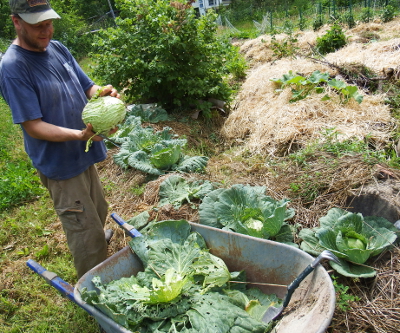 We'll eat some of these cabbages right away, then will freeze some and store some in the fridge to be added to harvest catch-all soup for winter. Unfortunately, despite last year's experiments with lactofermenting, we haven't come up with a fermented cabbage recipe that we enjoy.
We'll eat some of these cabbages right away, then will freeze some and store some in the fridge to be added to harvest catch-all soup for winter. Unfortunately, despite last year's experiments with lactofermenting, we haven't come up with a fermented cabbage recipe that we enjoy.
On the plus side, goat cheese
seems to feed our guts with the same bacteria and fungi you'd get in
sauerkraut, and Mark notes that his tummy feels better this year than
ever before. My stomach, on the other hand, never needs any help,
presumably because of those gallons of dirt I ate as a child.
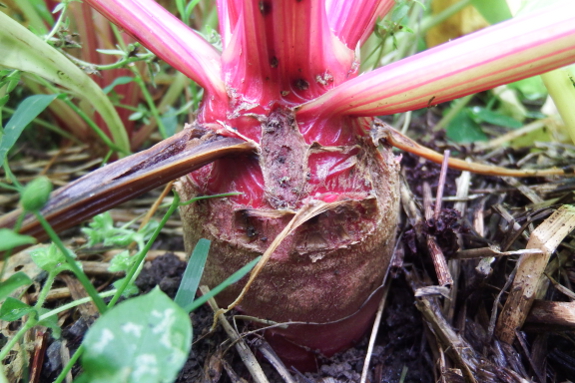
This is the first year we're growing mangel beets to feed our goats this Winter.
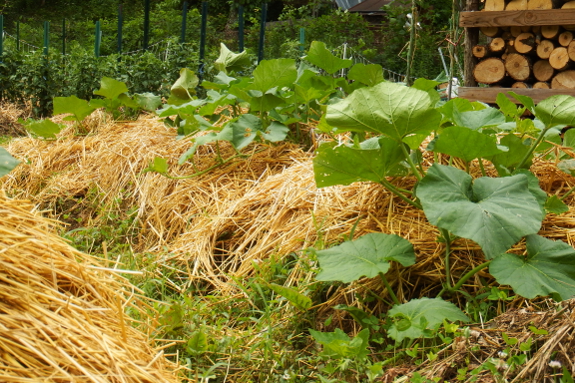
Sometimes I get so
engrossed in the minutiae of homesteading that I forget to share the big
picture. So here's a disjointed post with a few photos of last week's
triumphs. Above --- the forest garden weeded and mulched, with tomatoes,
sweet potatoes, and butternut squash thriving.
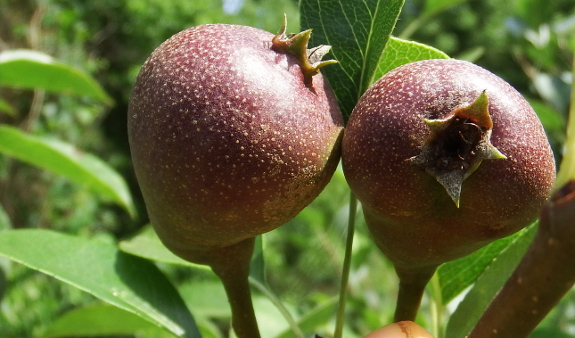
Summer pruning
completed...and three baby seckel pears discovered amid the foliage! I
guess that late frost didn't get quite all the blooms (although it did
twist the developing fruits a little).
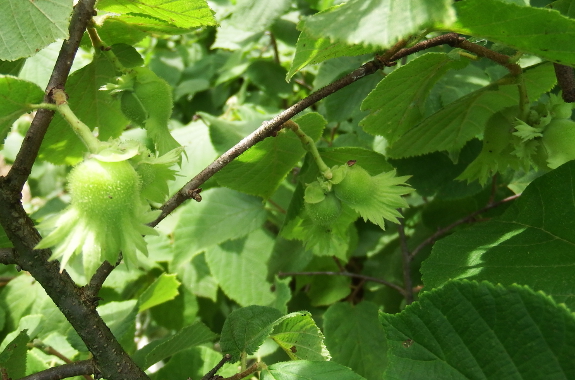
Another happy surprise --- our hazel bush
is completely loaded! The only troubling fact? For the first time ever,
squirrels entered our yard last year, as evidenced by the dozens of
walnut seedlings I've been pulling out of various parts of the garden
this spring. Will the tree rats get our delicious nuts?
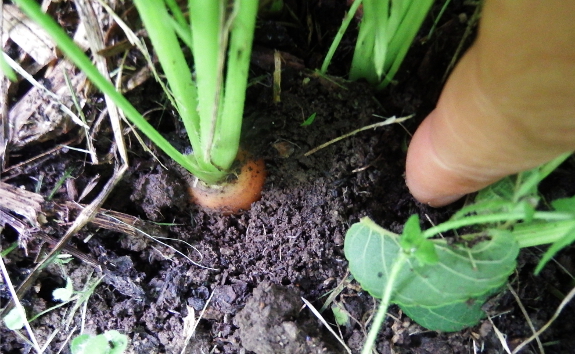
In the vegetable garden,
we're starting to hit the stage where there's so much produce that the
freezer and larder are slowly filling back up. The newcomer this week is
baby carrots, which I pull out to thin the beds. Nothing like carrots
to remind me of how much our soil has improved over the last nine years!
I hope you'll take a step
back from frowning at the weeds and pests today to enjoy the beauty of
summer. Now's a great time to take pictures so green they'll make your
eyes pop in January. Happy solstice!
It's a long shot...but we decided to try to propagate some Chicken of the Woods pieces in a bowl of wet corrugated cardboard.
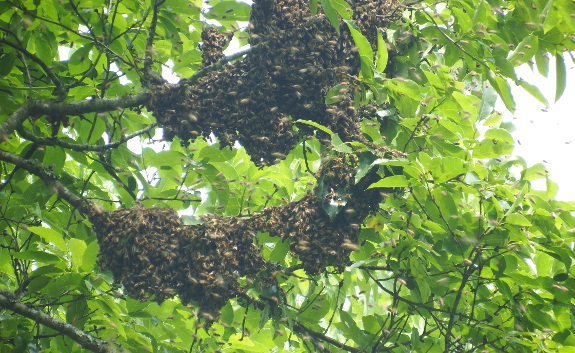
I feel like such an
amateur at beekeeping, even though we've kept hives for six years now.
Which is my way of saying --- I messed up.
When I visited our bees a few days after our swarm-prevention split,
I was pretty sure I knew which hive had kept the old queen. And I was
100% sure that the queen-right hive had swarm cells in it. But, I left
the extra queen cells alone because...what if I was wrong about that
hive having a mature queen? And what if I killed all of the colony's new
potential queens and the whole hive bit the dust?
I should have been brave, though. Because one of those queens hatched out Friday 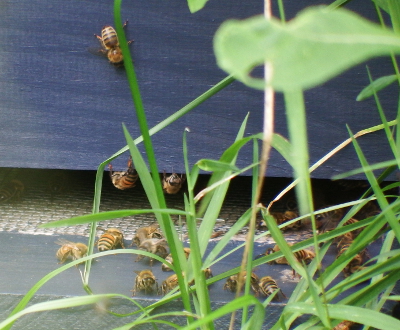 afternoon.
As a result, a tremendous mass of bees rose out of the hive with the
old queen, sat for three hours on a very tall limb, then flew away. The
photo at the top of this post captures the swarm when about 70% of the
bees were still in the air, if that gives you an idea of how many bees
flew the coop.
afternoon.
As a result, a tremendous mass of bees rose out of the hive with the
old queen, sat for three hours on a very tall limb, then flew away. The
photo at the top of this post captures the swarm when about 70% of the
bees were still in the air, if that gives you an idea of how many bees
flew the coop.
Which isn't the end of
the world since the swarm's old home now boasts a new queen and at least
some workers to carry them through. And the break in brood cycles is a
sure-fire way of lowering varroa-mite levels. But it also dramatically lowers our chance of honey this year.
Now both mother and
daugher hive are back on the sugar-water wagon for the foreseeable
future as they raise new queens and get their feet back under them.
Hopefully they'll at least go into winter as two healthy colonies...and
by this time next year, the bees will be back in Langstroth hardware so I can manipulate them more easily and prevent future swarms.
And maybe in another decade or so, I'll stop feeling like such an an amateur apiarist....
We lost power yesterday about
an hour before sunset.
It only took a few minutes to
hook up what might be the best
DC fan money can buy.
I have tried several battery
powered fans and this one is in a class by itself. The battery I used
was from the old truck we took to the crusher over three
years ago. I was surprised it still had enough charge to last all
night on low...maybe I could've increased to the next speed without
draining the battery.
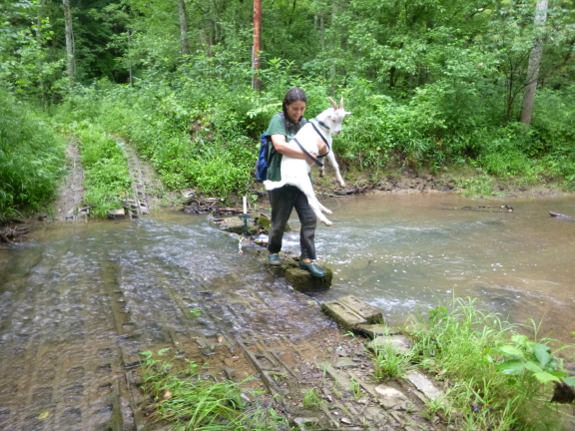
As an omnivorous
homesteader, there comes a time when you have to put your money where
your mouth is and kill that animal. For our first trial with homegrown
red meat, we opted to take the halfway-house approach and drive Lamb
Chop to the butcher. But I'll admit I still shed more than one tear over
the endeavor.
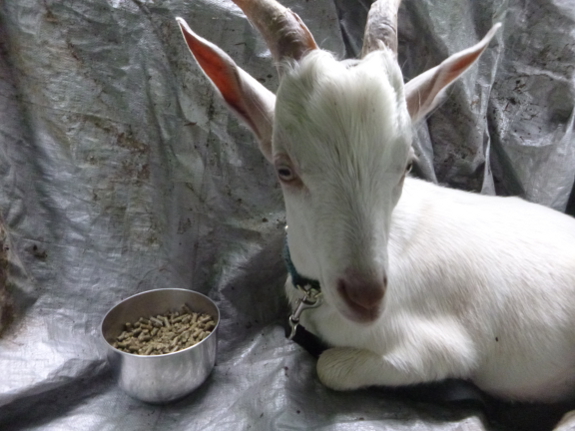
Honestly, I'd thought the
hardest part would be getting our buckling across the creek and into
the car, but he's used to following my lead. Yes, Lamb Chop and his
mother (and Artemesia) cried as if the entire world was on fire as I led
him away...but once I paused and let our buckling nibble on a mouthful
of leaves he forgot all about the herd in a heartbeat. Instead, he
followed me agreeably, submitted to being hoisted across the creek,
hopped up onto the tarp-covered backseat with a bribe of alfalfa
pellets, and then simply lay quietly with my arm across his back for the
entire drive.
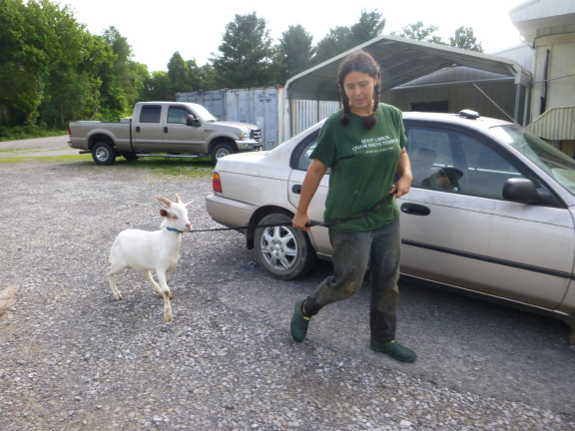
Only when we emerged from
the car did he balk, and that was merely because the world was big and
scary with a highway only a few yards away.
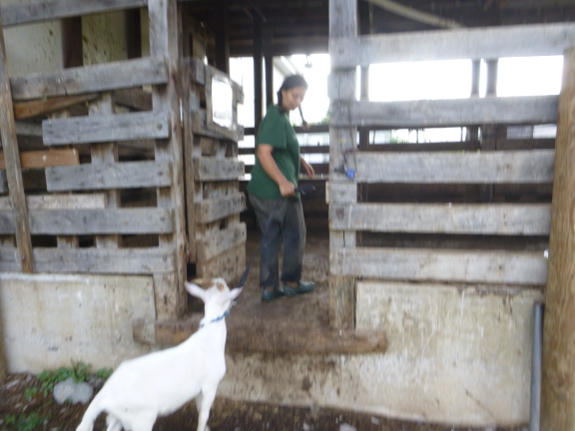
Without much prodding, our kid followed me into the slaughter room. Then I took off his collar, and we drove away.
(That's when I cried.)
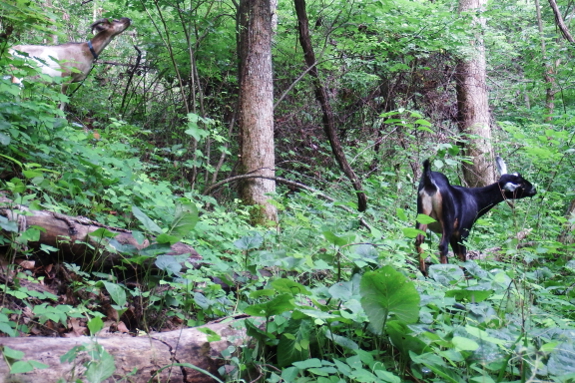
And, yes, the truth is
that I let myself love our first homegrown kid a little too much. Even
though he'd started harassing Artemesia (despite never quite finishing
the job) and headbutting my legs when we walked together (in jest...he
said!) and gnawing on my yoga mat (even though I continually pushed his
nose away), I nicknamed our buckling Choppy and scratched behind his
horns and let him lay down beside me as I read. Yes, despite protestations to the contrary, Lamb Chop and I were friends.
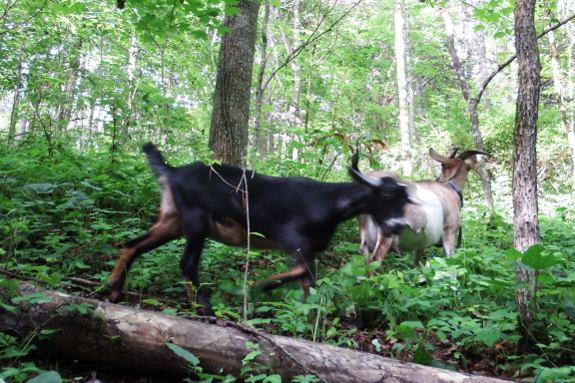
I expected Abigail to cry
all day after losing her kid, but the coop was ominously silent after
Mark and I got home. And I'll admit that I dreaded my usually
lusted-after evening grazing session that day --- I halfway expected our
doe to call me a murderer when I came out to play. Instead, she was
ready to eat, only looking up twice to call out Lamb Chop's name before
putting her mind back to the serious business of grazing.
It was quieter in the woods without Lamb Chop present, but more peaceful
too. And I learned at dusk that our buckling had been getting two thirds of
Abigail's daily milk. Choppy, I thought we'd agreed to go halfsies!
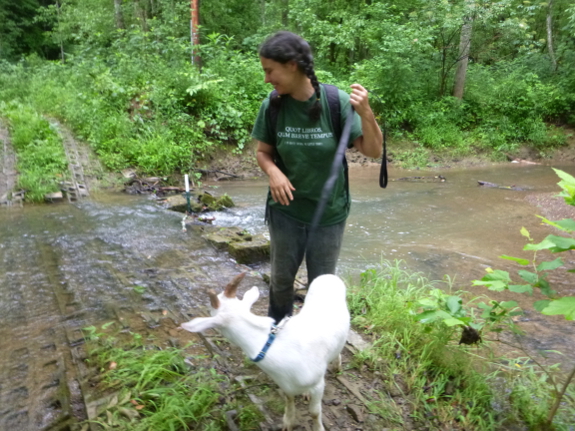
Which brings me back to
the reality of homesteading --- if you want milk, there are offspring
about once a year and 99% of the boys are really only good for meat.
(The world would overflow with wethers in short order if we castrated
all the males and tried to give them away as pets.)
So even though I shed a
tear when I said farewell to Choppy, Mark and I still felt like we were
doing the right thing. Next year, I'll probably be a little more distant
with our kids...and maybe they'll be a little less magical in response.
But as Tennyson said (about something else entirely), it's better to
have loved and lost than never to have loved at all. So, for this year at least, I wouldn't have changed a thing.
Anna has gotten so good at scything I decided to put her in charge of
our little hillside near the gully.
I think it's one of those occasions where the scythe is less calories
burned compared to holding a weed trimmer at that angle.
 Now's
your chance to snap up four of my ebooks at a dramatically reduced
price! You'll need to mark your calendar, though, to catch each sale on
the proper day.
Now's
your chance to snap up four of my ebooks at a dramatically reduced
price! You'll need to mark your calendar, though, to catch each sale on
the proper day.
I start off today, June 24, with Homegrown Humus marked down to 99 cents.
Tomorrow, June 25, I'll bring you Thrifty Chicken Breeds at 99 cents.
We'll take the weekend off so you have time to digest this week's cheap books. Then next Monday, June 29, we'll jump back on the sale bandwagon with Pasture Basics marked down to 99 cents.
And we'll finish our sale next Thursday, July 2, when Growing into a Farm is also 99 cents.
As a side note, if you
want to be reminded on each of these sale dates, you'll see my books in
Buck Books' daily newsletter during this time period. Click here to subscribe and find lots of other 99-cent books too!
Finally, in case you're interested, I'm currently hard at work on The Ultimate Guide to Soil,
which will reach you in ebook form this winter and in print form next
summer. One of the holes in my rough draft is container gardening --- I
haven't done much of it but know that many people only have space for a
few pots on their patio. If you've got some great photos and tips about
container gardening that you'd like to share, I hope you'll take a
minute to email me back and I may include your information in the final
book.
Thanks for letting me
take a day out of my usual round of gardening geekery and goat
gallivanting for a bit of shameless self-promotion. I hope you enjoy the
books!
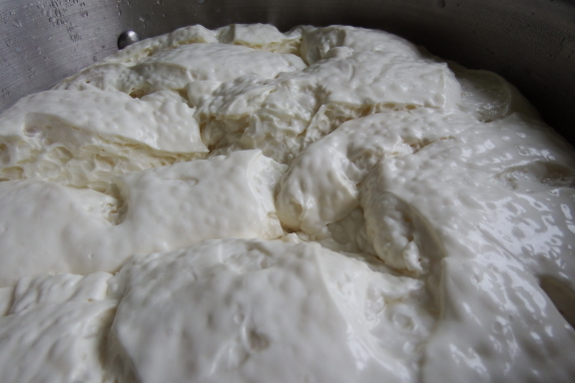
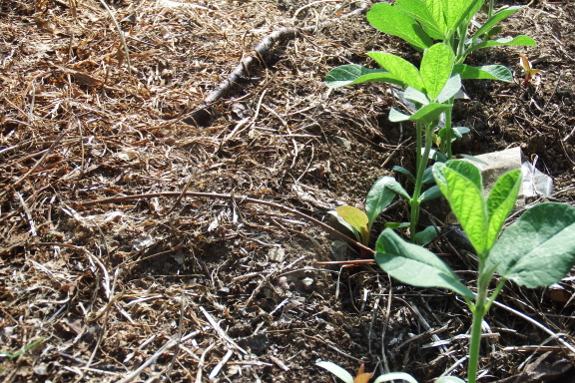
The photo above shows the results of two different solarization experiments. On the right, two-week-old soybeans are happily growing in ground that used to be a mass of ground ivy prior to solarization
(begun two weeks before planting). The weeds have nearly completely
decayed into the soil and the soybeans appear to be thriving. There are a
few smartweeds coming up from seeds, but none of the perennial weeds
have regrown at all.
On the left, you can see a
newly solarized area, the ground-ivy debris still lying dead on the
soil surface. I could have ripped up those weeds by hand, but the bed
would have lost all of that organic matter and my fingers would have
been exhausted afterwards. Instead, five minutes of work results in
richer soil ready for a round of cover crops.
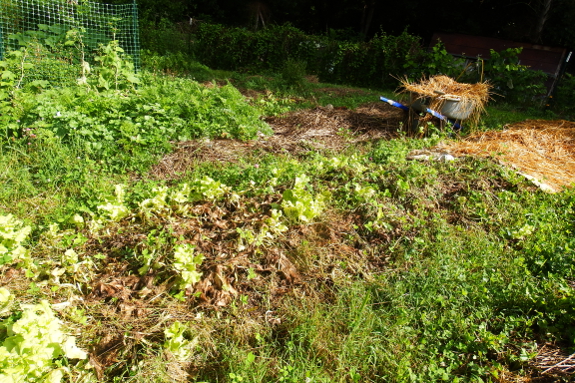
I've been pretty
tentative with my solarization experiments so far because I initially
didn't buy into the technique. But with so many successes under my belt,
I asked Mark to buy me another roll of clear plastic and am preparing
half of our brussels sprouts beds using the lazy-gardener method. The
photo above shows a bed that used to be weedy lettuce (full of red
clover), which I scythed, then topdressed with soiled goat bedding, and
(after the photo was taken) covered with a sheet of clear plastic. I'm
excited to see what the soil will look like in three weeks when the
brussels sprouts are ready to go into the ground. Maybe solarization
will become my fast-and-easy soil prep step in future garden years?
Our hornets
from last week moved back
into that same pear tree.
Maybe I should've burned them
like Sheila suggested, but this time I just walked them a lot further
from our perimeter.
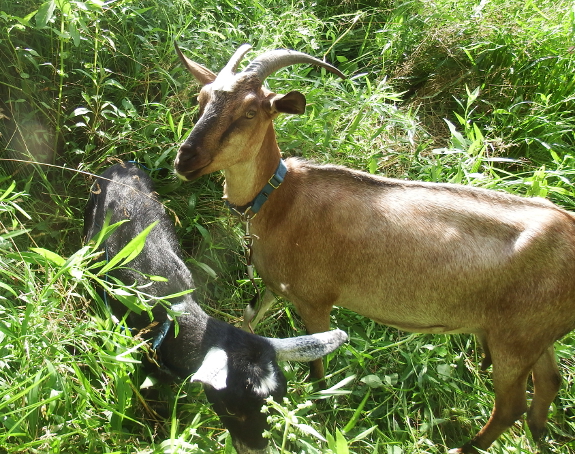
One of the most joyful parts of having our herd whittled back down to two is that I can return to morning tethering. I still take the girls out for their woodland grazing
in the evening, so now I just tether until Abigail grows bored about an
hour into her grazing period. To me, our doe doesn't look full after
sixty minutes of tethering, but I have to accept that our goat knows
what she wants.
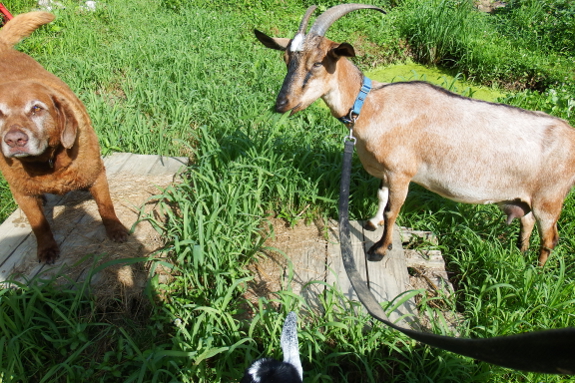
Which isn't to say that
our pair of capricious beasties don't stop for a few more mouthfuls of
succulent treats on the way back to the coop. Here, Lucy is reminding
the goats that the porches (a couple of feet to the left of the photo)
belong to her.
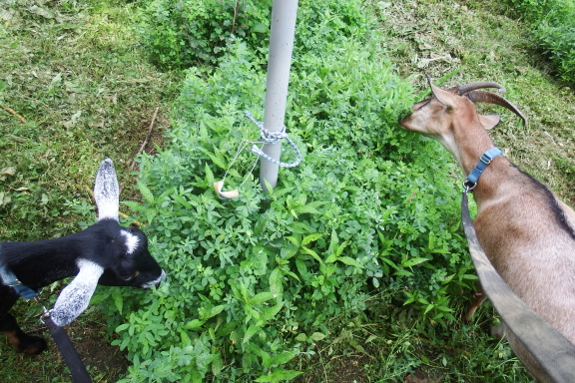
A few mouthfuls of
alfalfa make a good post-breakfast dessert. Then back to the coop to nap
and chew their cuds until after the humans' dinner. Such a fun way to
start the day, with an hour weeding beside the goats!
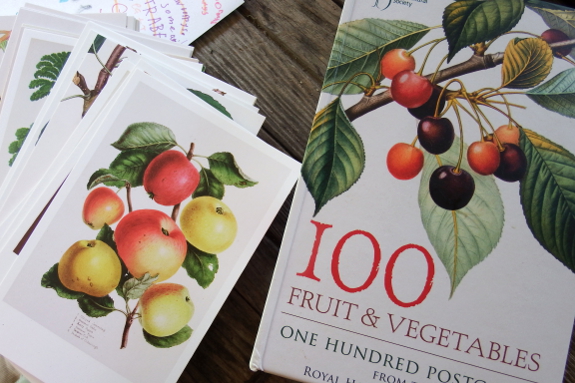
I used to write letters
to a few college friends and family members long-hand. The trouble is
that, in this age of computers, writing by hand feels terribly slow, so
we all got behind in our correspondence and began to consider the
letters a chore. Plus, it's hard to fill a letter with unique
information now that I share 90% of my daily thoughts with the world on
our blog.
Enter the postcard. This summer, I've been playing with these beautiful botanical postcards,
dashing off a line whenever I think of it and sending them to all and
sundry. Paper correspondence quickly became fun once again!
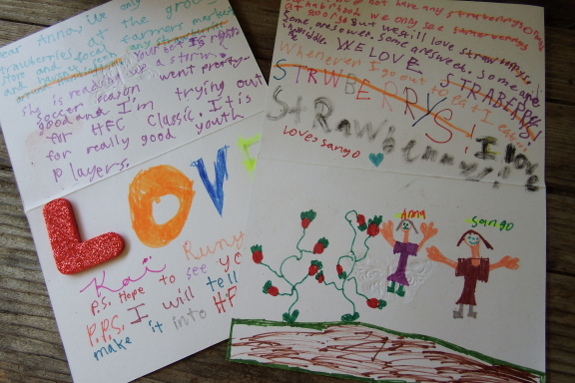
The first few weeks, it
felt like I was fishing. I'd send out postcards to people I hadn't heard
from in a while...then wait to see if they'd bite. My mom and I soon
settled into a weekly postcard routine, and my grand-niece and
grand-nephew came through with the amusing replies above. Glad I'm not
the only one who likes strawberries!
I know this post has very
little to do with homesteading. But the moral is --- if something used
to be fun but became a chore, shake it up and make it fun again! And, if
you can't think of your own unique spin, you could do far worse than
joining me in the summer of the postcard.
This is the year we'll be giving up on rabbiteye blueberries and replacing them with more northern highbush.
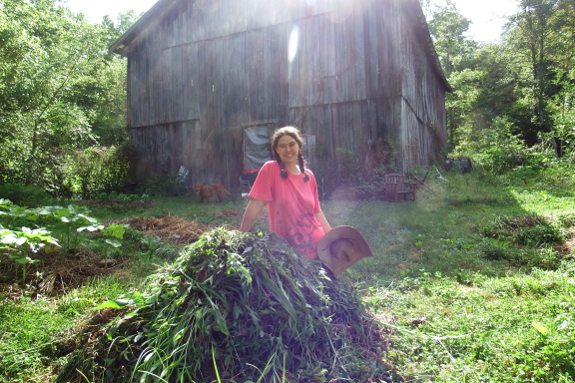
I often use garden weeds
to hold down newspaper or cardboard kill mulches around berries or to
lower weed pressure under large fruit trees. But the weeds were growing
faster than I could use them in June, so this week I gathered up two
days worth of weeds to make a compost pile.
The photo above shows the pile before I added a bucket of bokashi-food-scraps and another two wheelbarrow-loads of weeds on top. Next up --- daily urine deposits to start rotting down the relatively high-carbon compost pile. It sure was fun to mound up my weeds, so I might make another compost pile next week!
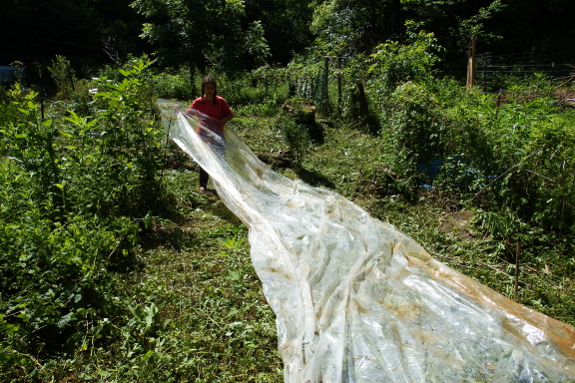
In other soil-related news, Mark had the bright idea of solarizing
the last remaining weed patch within our core homestead. This area gets
mowed maybe once a year, and in between it tends to grow up into
blackberries and ragweed. My hard-working husband whacked the weeds to
the ground and then we laid down a sheet of plastic to see if this
technique can work its magic in an area with much higher weed pressure
than we've tried it on previously.
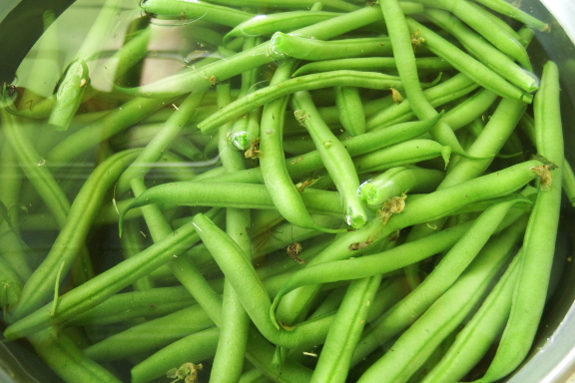
And now that you've seen
the weediest parts of our core homestead, I'll end with a happier photo
--- the summer's first green beans. Sauted with homegrown garlic and a
bit of salt, they were delicious!
The scarlet
runner beans are over 7 feet tall.
I'll bet they could go as
high as 50 feet under the right conditions?

Between morning and
evening milkings Saturday, I collected my mom and went back in time to
the nineteenth century. The age of steam!

 Back when steam trains were starting to go out of style, the Tennessee Valley Railroad Museum
started buying up engines and passenger cars in an effort to keep at
least a few of these old-timey trains on the rails. They renovated the
steam trains, and now you can take short or slightly longer trips behind
a coal-powered locomotive. When I saw that a day trip was leaving from
Bristol (1.25 hours from our farm and a five minute walk from my mom's
house), I was hooked. My summer adventure had been decided!
Back when steam trains were starting to go out of style, the Tennessee Valley Railroad Museum
started buying up engines and passenger cars in an effort to keep at
least a few of these old-timey trains on the rails. They renovated the
steam trains, and now you can take short or slightly longer trips behind
a coal-powered locomotive. When I saw that a day trip was leaving from
Bristol (1.25 hours from our farm and a five minute walk from my mom's
house), I was hooked. My summer adventure had been decided!
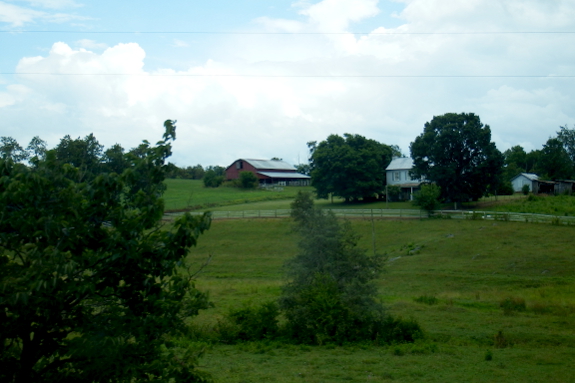
After enjoying the rush
of watching the steam locomotive back the train up to the historic
Bristol train station, Mom and I climbed aboard and settled in to watch
the scenery pass by. Although we were paralleling a minor highway (11E)
the whole way, it was intriguing to see the countryside from a different
perspective. Even just a few miles from the highway, the landscape was
pastoral, full of cattle pastures, ancient farm houses, and the
occasional backyard garden.
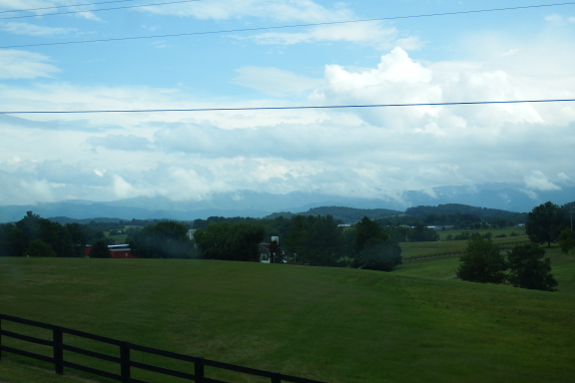
I'm pretty sure I noticed someone emulating Salatin's egg-mobile along with an example of Bartholomew's Square Foot Gardening method.
There were blooming mimosas and trumpet vines, one wild deer, and at
least a hundred interested people parked at crossroads with cameras in
hand, ready to record the steam locomotive's charismatic presence (and
to wave us on our way).

About halfway through the
journey, Mom and I decided it was time to explore! So we set out to
walk to the commissary car in the middle of the train, four cars
forward. I loved the gaps between cars, where you could hear the wheels
turning beneath you and felt closer to the world whooshing by outside.

And then, before we knew it, we'd reached our destination --- the tiny town of Bulls Gap, Tennessee. It felt like all 719 residents were involved in welcoming us with a festival erected in our honor. There were tents full of sale items, two museums opened for our perusal, and a delightful bluegrass band playing live music.

Yes, with nearly a
quarter of the town's population living below the poverty line, I'm sure
the goal was to grab some much-needed tourist dollars. But the event
had the feel of a down-home welcome anyway, and Mom and I dove right in.
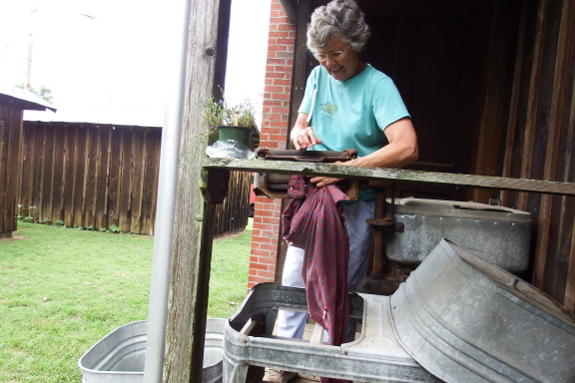
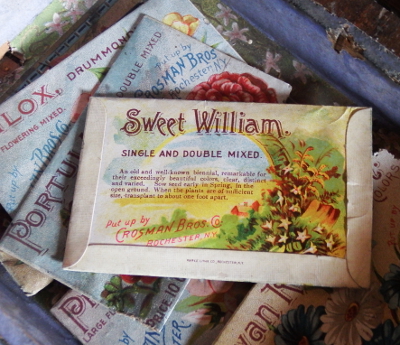 The museums were a little too packed for comfort (at least for this introvert), but the homeplace of Archie Campbell
was more my style. The house is furnished with period stoves, beds, and
other paraphernalia, and nothing is marked as hands-off. You can play
with the wringer washer and hand-cranked record player and can pick
through ancient packets of flower seeds to enjoy the artwork. If you're
ever in the area, I recommend dropping by Bulls Gap to see for yourself.
The museums were a little too packed for comfort (at least for this introvert), but the homeplace of Archie Campbell
was more my style. The house is furnished with period stoves, beds, and
other paraphernalia, and nothing is marked as hands-off. You can play
with the wringer washer and hand-cranked record player and can pick
through ancient packets of flower seeds to enjoy the artwork. If you're
ever in the area, I recommend dropping by Bulls Gap to see for yourself.
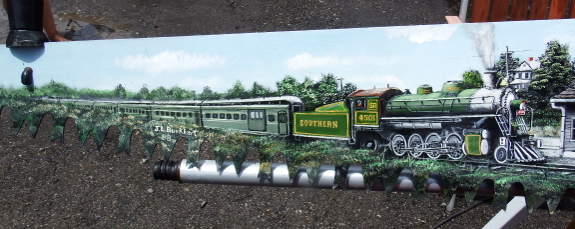
Back in the melee of
tents, Mom picked up a book by a local herbalist (which came with a free
plant), and then we marveled over a scene painted on a saw blade. The
section photographed above shows the very engine we rode into town
behind.
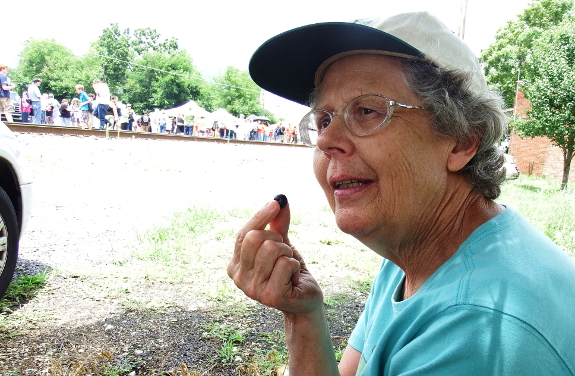
We were allotted an hour
in Bulls Gap, which was just about right. Although the train folks
kindly provided us box lunches before we reached our destination, I'd
also packed homegrown goodies since I don't trust the outside world to
feed me properly anymore. So Mom and I munched on cucumber sticks,
blueberries, and brownies, washing it down with slowly-thawing jars of
frozen goat's milk. I felt a bit bad for the folks trying to sell us hot
dogs, popcorn, and soft drinks...but, really, which snack would you
prefer?

And then engine 4501 pulled back into the Bulls Gap downtown and we climbed aboard.

(Here's an extra photo of Mom with her plant in front of the locomotive, just because.)
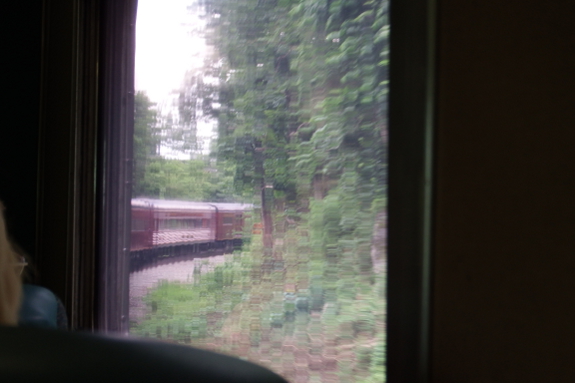
The ride home was quieter as we all drifted back into the beauty of the surrounding scenery.

And just when I was
starting to think that Abigail would be pissed if I was gone much
longer, we pulled up to the Bristol station in a pounding rain. Maggie
had kindly brought the car down to pick us up so we didn't get soaked,
and she'd cooked up Lamb Chop's right front leg into a delicious supper.
But more on that later since this post is already far too long. In the meantime, I hope you enjoyed coming along for the ride!
I don't usually bore you
with too many book posts, but I'm hoping you'll bear with a bit more
publishing news. First of all, if you missed last week's summer sale post, Homegrown Humus is marked down to 99 cents for one more day, you've got two days left to snap up Thrifty Chicken Breeds on sale, Pasture Basics went on sale this morning, and Growing into a Farm will join the 99-cent ranks on Thursday.
But that's not what I
really want to tell you about this afternoon. Instead, I'm escaping the
world of homesteading for a few minutes in order to share Aimee
Easterling's big news. I've been helping Aimee publish her novels
through Wetknee Books, and one of those titles is now included in a box set
that went on sale this morning. For a limited time, you can snap up all
21 novels for only 99 cents, meaning that even speed readers like me
could have a whole month of reading for less than a buck. What a great
deal!
The overarching goal is
to help the box set hit the USA Today and New York Times bestseller
lists. We have the first of these in the bag (we hope), but it's going
to take some serious book-selling if we want Aimee to be able to call
herself a New York Times bestseller.
 To
that end, I hope you'll take a minute to share the news with anyone who
enjoys paranormal fantasy. And, if you wrote a review of Shiftless when
it first went live, I hope you'll take a minute to copy and paste that
review over onto the box set page. Then email me
with a link to your review by the end of the day today and I'll put
your name in the hat. One lucky reviewer will be receiving signed
paperback copies of both of Aimee's werewolf books (or, if you prefer,
of The Naturally Bug-Free Garden and The Weekend Homesteader). I hope
that sweetens the pot and makes you more likely to spend three minutes
at the keyboard this afternoon.
To
that end, I hope you'll take a minute to share the news with anyone who
enjoys paranormal fantasy. And, if you wrote a review of Shiftless when
it first went live, I hope you'll take a minute to copy and paste that
review over onto the box set page. Then email me
with a link to your review by the end of the day today and I'll put
your name in the hat. One lucky reviewer will be receiving signed
paperback copies of both of Aimee's werewolf books (or, if you prefer,
of The Naturally Bug-Free Garden and The Weekend Homesteader). I hope
that sweetens the pot and makes you more likely to spend three minutes
at the keyboard this afternoon.
Book sales are what give
me the leisure to experiment in the garden all day and share my
learnings with you, so I really appreciate your efforts to make Aimee's
box set a success.
And thank you so much for bearing with this commercial break!
We're getting a little behind
schedule on our firewood cutting.
The Oregon
battery powered chainsaw has been my main saw since the gas powered
Stihl developed compression problems and had to be put out to pasture.
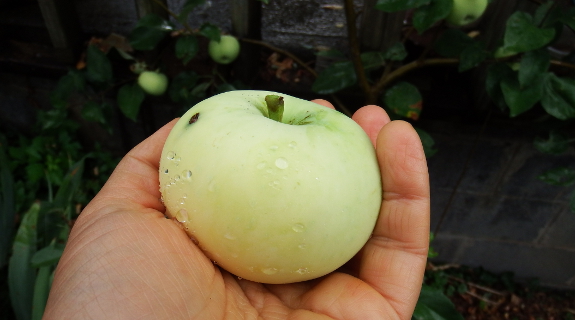
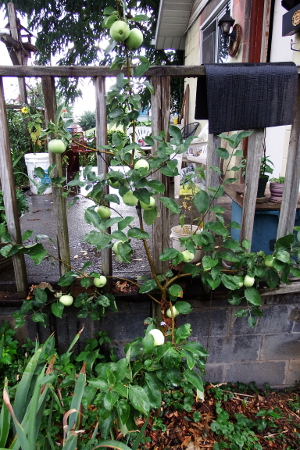
In my last post,
I left you at the train station, but my girl's day out wasn't over
quite so soon. Mom and Maggie brought me home for supper...and to ooh
and aah over their dwarf apple tree.
I can't remember the
exact dates, but I'm guessing this tree has been in the ground for only
three years. It's trained as a natural-form espalier,
and due to the city location (pavement holds heat), late spring freezes
don't harm the blooms. You can see the result...a tree dripping with
apples even after about a dozen fruits have been harvested. I'm green
with envy!
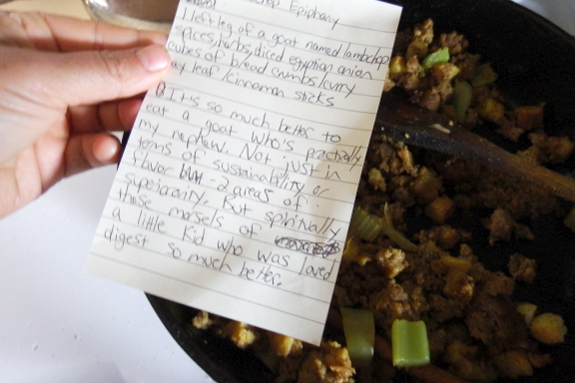
The other excitement
major enough to keep me away from my milking for an extra half hour was
tasting Lamb Chop's first culinary debut. I brought Maggie a pound of
ground goat meat the morning of our adventure, and while Mom and I were
on the train, Maggie was cooking up a storm. The result was so
delectable that I thawed out some chops, marinated them, and cooked them
up for me and Mark the next day.
The consensus is that
3.75-month-old goat tastes every bit as good as lamb...possibly even
better. There's no gamy flavor (although the meat is very slightly
tougher than lamb) and the fat-to-meat ratio is the best of all the
pastured meats we've tried so far (purchased lamb and beef and hunted
venison).
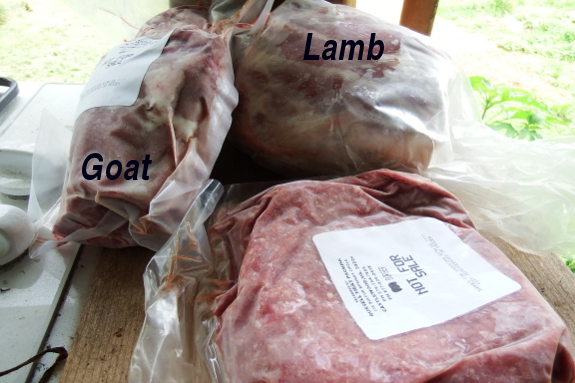
As for cost --- the $55
we paid to the slaughterhouse was very much worth it. We ended up with
26 pounds of goat meat (which I think includes the weight of the bones I
requested to have returned to me for broth-making), and the thinly
sliced steaks and ground meat will definitely making cooking with our
homegrown chevon much easier. Considering that we've been willing to pay top dollar for pastured lamb in the past, the slaughterhouse fee is  quite
acceptable for meat that is otherwise nearly free. Suddenly, I'm
wishing Abigail had popped out two kids instead of one, and I'm looking
forward to an even larger goat harvest next summer.
quite
acceptable for meat that is otherwise nearly free. Suddenly, I'm
wishing Abigail had popped out two kids instead of one, and I'm looking
forward to an even larger goat harvest next summer.
Finally, I should end by
mentioning that there doesn't seem to be a perfect age for harvesting
goats for meat. A quick search of the internet turns up dates ranging
from two months to two years, with the data that growth starts to slow
(meaning the meat gets much tougher and feed costs rise if you're
purchasing food) at an age of about five to six months. So, even if Lamb
Chop hadn't been making my life more difficult, butchering him at four
months was probably a relatively good idea.
And, despite my angst at the time,
I haven't experienced a single qualm as we gorge on our first
buckling's meat. Instead, I fall more and more in love with our caprine
homestead addition every day. The only real question is --- which is the
most valuable goat product? Milk, manure, or meat?
Our new harvest sickle has a
stainless steel blade with deep serrations.
It's an impressive cutter
that made short work of this large comfrey.
Want more in-depth information? Browse through our books.
Or explore more posts by date or by subject.
About us: Anna Hess and Mark Hamilton spent over a decade living self-sufficiently in the mountains of Virginia before moving north to start over from scratch in the foothills of Ohio. They've experimented with permaculture, no-till gardening, trailersteading, home-based microbusinesses and much more, writing about their adventures in both blogs and books.


